87 Flowering Shrubs (with Pictures): Identification Guide

Flowering shrubs add a touch of color and beauty to any garden landscape. Aside from beauty, they also attract pollinators and can be used as a privacy screen, hedge or accent plant. Flowering shrubs are perfect for boosting curb appeal when planted in the front of house. Some of these shrubs also fill the air with their own unique fragrance. From the showy camellia to the iconic rose of Sharon, there are many flowering shrubs to choose from.
This article is a comprehensive identification guide to small and large flowering shrubs. Descriptions and pictures of various shrubs will help you select the perfect addition to your garden.
Pink Flowering Shrubs (with Pictures): Identification Guide
Here are the most beautiful pink flowering shrubs for landscaping your garden:
Camellia (Camellia)

Camellias are evergreen shrubs with colorful flowers that are suitable for partially shaded gardens
Camellias are evergreen shrubs known for their attractive pink, red, or white blossoms. The single or double flowers bloom in late winter or early spring. Flourishing in shaded areas, camellias feature long-lasting flowers and have a waxy texture. Additionally, the shrub’s resilient, leathery, evergreen leaves provide a year-round burst of color to gardens.
Typically, camellias are slow growers, ranging from 2 to 20 ft. (0.6 – 6 m) in height and up to 10 ft. (3 m) in width. They thrive best in conditions of partial to full shade. The shrub is a cherished choice among gardeners who appreciate the beauty and endurance of pink camellia shrubs in their gardens.
- Mature Size: 2 to 20 ft. (0.6 – 6 m)
- USDA Zone: 6 to 9
- Sun Exposure: Filtered sunlight, partial shade, or full shade
- Soil Type: Well-drained, acidic soil
Rose of Sharon (Hibiscus syriacus)
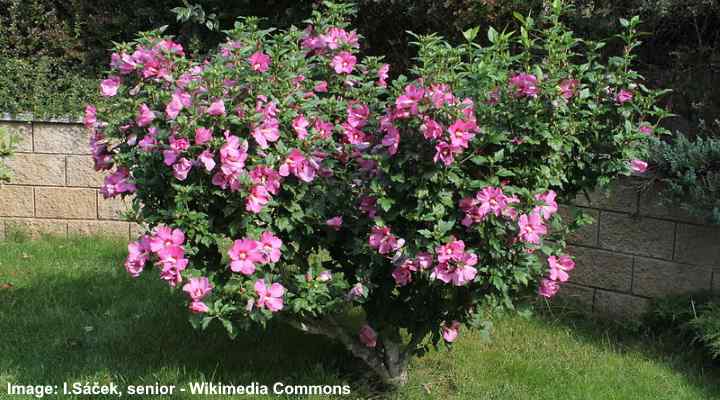
The rose of Sharon is a deciduous shrub that produces large, striking, deep pink flowers that bear a resemblance to hollyhocks. Distinguishing characteristics of this hardy hibiscus include its vase-like form, broadly ovate leaves with three lobes, and exquisite trumpet-shaped pink blooms. The shrub’s unique funnel-shaped flowers can reach a diameter of up to 4 inches (10 cm).
Rose of Sharon shrubs can reach heights of 8 to 12 ft. (2.4 – 3.6 m) and spread 6 to 10 ft. (1.8 – 3 m). They have the ability to thrive in a wide variety of soil types, although they prefer well-drained soil. Their dense foliage and captivating flowers make them ideal for creating visually appealing hedges, borders, and specimen plants. In addition, they exhibit drought tolerance once they have become established.
- Mature Size: 8 to 12 ft. (2.4 – 3.6 m) tall and up to 10 ft. (3 m) wide
- USDA Zone: 5 to 8
- Sun Exposure: Full sun to partial shade
- Soil Type: Organically rich, acidic soil that drains well
Weigela (Weigela florida)

The weigela is a deciduous shrub that is known for its clusters of exquisite trumpet-shaped pink flowers. This densely rounded shrub also has narrowly ovate leaves. Its appealing, pink funnel-shaped blooms cover its branches from late spring to summer. These blossoms have a reputation for attracting pollinators such as bees and butterflies.
The weigela is a resilient shrub that can withstand cold temperatures and requires minimal maintenance. It is also tolerant of drought conditions and can adapt to various soil types. This bushy plant, adorned with pink flowers, thrives in areas with partial shade and can reach a height of 6 to 10 ft. (1.8 – 3 m). The weigela can be utilized in landscaping for purposes such as creating shrub borders, hedges, foundation plantings, or as a striking focal point in a garden setting.
- Mature Size: 6 to 10 ft. (1.8 – 3 m)
- USDA Zone: 4 to 8
- Sun Exposure: Full sun, dappled sunlight, or partial shade
- Soil Type: Well-drained soil
Beautybush (Kolkwitzia amabilis)

The beautybush is an upright, deciduous shrub known for its attractive pale pink flowers that bloom during spring. Some decorative features include its upright-arching branches, oval-shaped dark green leaves, and clusters of small pale pink, bell-shaped flowers. The shrub grows 6 to 10 ft. (1.8 – 3 m) tall and wide. It is ideal for adding a vertical element to a landscape.
The beautybush’s flowers are highly fragrant, attracting pollinators such as butterflies and bees. This low-maintenance shrub can tolerate most soil conditions. Landscaping ideas include growing it as a foundation plant, shrub border, screen, or flowering hedge. Additionally, the shrub’s exfoliating bark adds to its appeal.
- Mature Size: 6 to 10 ft. (1.8 – 3 m) tall and wide
- USDA Zone: 5 to 9
- Sun Exposure: Full sun to partial shade
- Soil Type: Average, medium moisture soils with excellent drainage
Tamarisk ‘Pink Cascade’ (Tamarix ramosissima)

The tamarisk ‘Pink Cascade’ is a hardy, deciduous shrub characterized by its feathery plumes of pale-pink flowers. The shrub has a loose, open, spreading form. Other identifying features include its arching branches and needle-like, gray-green, scaly leaves. This easy-care shrub is highly resistant to drought, pests, deer, and unfavorable soils.
The tamarisk ‘Pink Cascade’ is frequently used in coastal gardens for mass plantings. It can also be planted as a windbreak or informal hedge. The nectar-rich flowers of this shrub are especially attractive to butterflies, bees, and other pollinators. Its most attractive decorative features are its finely textured foliage and striking display of vibrant pink blossoms that envelop it during the summer. This shrub is drought-tolerant once established.
- Mature Size: 10 to 15 ft. (3 – 4.5 m) and 8 to 13 ft. (2.4 – 4 m) wide
- USDA Zone: 2 to 8
- Sun Exposure: Full sun
- Soil Type: Dry to medium well-drained soils, including poor soil
Pink Oleander (Nerium oleander)

Pink Oleander (Nerium oleander)
The pink oleander is a medium-sized, evergreen shrub that showcases five-petaled, funnel-shaped pink flowers. This pink-flowering shrub blooming season lasts throughout the summer. The shrub also features elongated, dark green leaves, a rounded growth habit, and loose clusters of pink blossoms. It is recognized for its ability to withstand windy conditions, salt spray, and drought.
The pink oleander grows 6 to 15 ft. (1.8 – 4.5 m) tall and up to 10 ft. (3 m) wide. The pink-flowering evergreen shrub can be grown as a year-round privacy screen, hedge, or individual specimen.
Although the pink oleander is beautiful, it is also toxic. Exercise caution when planting in areas that might be frequented by children or pets. In addition, the plant is not cold-hardy, so it should not be planted in places with severe winters.
- Mature Size: 6 to 15 ft. (1.8 – 4.5 m) tall and 6 to 10 ft. (1.8 – 3 m) wide
- USDA Zone: 7 to 12
- Sun Exposure: Full sun
- Soil Type: Medium moisture, well-drained soils
Pink Japanese Wisteria (Wisteria floribunda ‘Rosea’)

The pink Japanese wisteria is a medium-sized, fast-growing vining shrub recognized for its huge, drooping clusters of pale-pink flowers. The spreading, woody shrub features dark green, pinnate leaves and elongated, bean-like seed pods in autumn.
In late spring to early summer, the delicate pale pink flowers bloom, emitting a fragrant aroma that draws in pollinators such as bees and butterflies. This shrub can be grown over a pergola, trellis, or arbor. It can also be planted as an individual specimen plant.
- Mature Size: 10 to 25 ft. (3 – 7.5 m)
- USDA Zone: 5 to 9
- Sun Exposure: Full sun to partial shade
- Soil Type: Moderately fertile, well-drained soil
Crown of Thorns (Euphorbia milii)

The crown of thorns is an attractive thorny shrub characterized by greenish flowers with bright pink bracts. Other identifying features include leathery, oval-shaped, bright green leaves and thick, grayish-brown, thorny stems. The shrub grows 3 to 6 ft. (1 – 1.8 m) tall and up to 3 ft. (1 m) wide.
The crown of thorns produces a milky sap that is highly toxic and may cause skin irritation. This shrub is well-suited for use in landscaping borders, as a low-growing security screen, for foundation planting, or to create barriers. It is drought-tolerant once established.
- Mature Size: Up to 6 ft. (1.8 m) tall and 3 ft. (1 m) wide
- USDA Zone: 9 to 11
- Sun Exposure: Full sun
- Soil Type: Well-drained sandy or shallow, rocky soil
Common Heather (Calluna vulgaris)

The common heather is a hardy evergreen shrub with attractive bell-shaped pink flowers. This small shrub has upright stems with tiny, scaly, dark green leaves. The shrub stands out for its bronze or purple-red foliage during the autumn season.
The common heather’s versatility makes it ideal for various landscape settings. The spring to summer-blooming shrub stands out when planted in rock gardens and mixed borders. It’s also suitable for ground covering to achieve a natural look in a landscape.
The common heather is a hardy plant that requires minimal care, thriving even when left unattended. It displays excellent drought tolerance and can flourish in nutrient-poor, acidic soil.
- Mature Size: 6” to 24” (15 – 60 cm) tall
- USDA Zone: 4 to 6
- Sun Exposure: Full sun to partial shade
- Soil Type: Sandy or gravelly well-drained, acidic soils
Elderberry ‘Black Lace’ (Sambucus nigra ‘Black Lace’)

The elderberry ‘Black Lace’ is an upright, deciduous shrub known for its flat-topped clusters of creamy pink flowers. The deciduous shrub has finely-cut, deep purple leaves as well as edible purple-black elderberries. Additionally, the leaves turn an attractive red color in autumn. This variety of elderberry grows up to 6 to 8 ft. (1.8 – 2.4 m) tall and wide.
The elderberry ‘Black Lace’ serves as a valuable shrub for multiple landscaping needs. The rich, lacy foliage makes it well-suited for an informal screen or hedge. Other landscaping ideas include growing it as a foundation or specimen plant in mixed borders.
‘Guincho Purple’ is another variety of pink-flowering elderberry. It blooms in early summer with delicate pale pink flowerheads, followed by black elderberries in late summer and early autumn. In autumn, the purple leaves turn an attractive red shade.
- Mature Size: 8 to 15 ft. (2.4 – 4.5 m) tall with a spread of 4 to 8 ft. (1.2 – 2.4 m)
- USDA Zone: 4 to 8
- Sun Exposure: Full sun to partial shade
- Soil Type: Well-drained loamy soil with plenty of organic matter
Korean Spice Viburnum (Viburnum carlesii)

The Korean spice viburnum is a slow-growing, deciduous shrub known for its globular clusters of sweet-smelling pinkish-white flowers. The 3 inch (7.5 cm) wide, pale pink clusters contrast nicely with the opposite, dark green leaves. During the autumn season, its leaves transform into stunning hues of burgundy or wine-red.
The Korean spice viburnum reaches 4 to 8 ft. (1.2 – 2.4 m) tall and has a rounded shape. This low-maintenance, small shrub is ideal for creating a privacy screen, hedge, or improving a perennial border. It also looks attractive growing along a fence or foundation.
- Mature Size: 4 to 8 ft. (1.2 – 2.4 m) tall and wide
- USDA Zone: 4 to 7
- Sun Exposure: Full sun to partial shade
- Soil Type: Well-drained soil
Purple-Leaf Sand Cherry (Prunus × cistena)

The purple-leaf sand cherry is an upright, deciduous shrub characterized by its small, five-petaled pale pink flowers. This highly decorative shrub has a rounded growth habit and purple-red foliage. Ideal for both front and back yards, this slow-growing shrub reaches a height of 6 to 10 ft. (1.8 – 3 m) and spans 8 ft. (2.4 m) in width.
The purple-leaf sand cherry is perfect for growing as an ornamental hedge, foundation plant, or specimen plant. With its springtime blossoms, this appealing shrub is perfect for attracting pollinators. Aside from its appealing pink blossoms, the sand cherry has small edible fruits that are favored by birds and wildlife.
- Mature Size: Up to 6 to 10 ft. (1.8 – 3 m) tall and 5 to 8 ft. (1.5 – 2.4 m) wide
- USDA Zone: 2 to 8
- Sun Exposure: Full sun to partial shade
- Soil Type: Organically rich loamy soil that drains well
Yellow Flowering Shrubs (with Pictures): Identification Guide
Here are some attractive yellow flowering shrubs for landscaping your garden:
Pontic Azalea (Rhododendron luteum)

The pontic azalea is a bushy, medium-sized shrub known for its clusters of golden funnel-shaped blooms. The shrub also has oblong-shaped, mid-green leaves that turn attractive shades of red, yellow, and orange in autumn. From late spring to summer, the azalea blooms in bright colors and produces a sweet scent.
The pontic azalea grows 4 to 5 ft. (1.2 – 1.5 m) tall and wide. It does well in both full sun and partial shade, and once it’s established, it can tolerate drought. However, it requires regular watering during dry spells. This azalea is a fantastic landscaping option for bringing lively yellow hues to shrub borders, foundation plantings, hedges, or shaded gardens.
- Mature Size: 4 to 5 ft. (1.2 – 1.5 m) tall and wide
- USDA Zone: 6 to 9
- Sun Exposure: Full sunlight or Partial shade
- Soil Type: Well-drained humus-rich soil that is constantly moist
Yellow Lady Banks Rose (Rosa banksiae ‘Lutea’)

The Yellow Lady Banks rose, characterized by its stunning double yellow blossoms, is a shrubby climbing rose. Its charming clusters of small, double yellow flowers not only add beauty but also fill the air with a delightful fragrance. One notable feature is its thornless branches, adorned with smooth-edged leaves that remain evergreen in milder climates. In optimal conditions, these roses can reach an impressive height of up to 20 ft. (6 m).
The Yellow Lady Banks rose stands out as the most prolific bloomer. During the spring and early summer, this variety blankets the entire plant with pale yellow flowers. Its climbing nature makes it an excellent choice for covering fences, walls, pergolas, trellises, and other garden structures, adding a touch of elegance to your outdoor space.
- Mature Size: 15 to 20 ft. (4.5 – 6 m) tall and 6 to 10 ft. (1.8 – 3 m) wide
- USDA Zone: 8 to 10
- Sun Exposure: Full sun
- Soil Type: Well-drained, moist soil with plenty of organic matter
Japanese Rose (Kerria japonica)
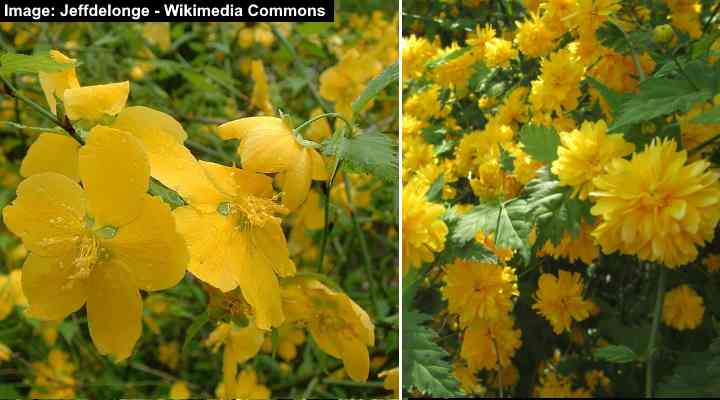
Japanese Rose (Kerria japonica)
The Japanese rose, a small decorative shrub, is popular for its charming yellow blooms that emerge in early spring. The blossoms bear a resemblance to roses and are either single or double. This shrub features small, deciduous, light green leaves that turn yellow in the fall. Additionally, this exceptional shrub is renowned for its appealing, bright green stems in the winter season.
The low-maintenance Japanese rose shrub reaches 10 ft. (3 m) in height. Its tall, arching branches form an irregular shape, adding visual interest to front gardens. This yellow-flowering shrub is ideal for foundation plantings, informal flowering hedges, and shrub borders.
- Mature Size: 8 to 10 ft. (2.4 – 3 m) tall and wide
- USDA Zone: 4 to 9
- Sun Exposure: Full sun, partial shade, or full shade
- Soil Type: Medium moisture, well-drained soil
Northern Spicebush (Lindera benzoin)

The northern spicebush is a rounded, deciduous shrub native to eastern North America. The early-blooming shrub can be recognized by its slender branches, lush 5-inch (12 cm) long pale green leaves, and its round, vivid red fruits. During the autumn season, the shrub’s leaves transform into a radiant golden-yellow hue.
The foliage and fruit of the northern spicebush release a delightful spicy aroma when they are crushed. This tall, multi-stemmed shrub flourishes in partial shade but can also endure full and partial sun exposure. It is well-suited for use as a hedge or screen, and it prospers in wet, marshy areas near streams and ponds.
- Mature Size: 6 to 12 ft. (1.8 – 3.6 m) tall and wide
- USDA Zone: 4 to 9
- Sun Exposure: Full sun, partial shade, full shade
- Soil Type: Slightly acidic, moist, well-drained soil
Witch Hazel (Hamamelis virginiana)
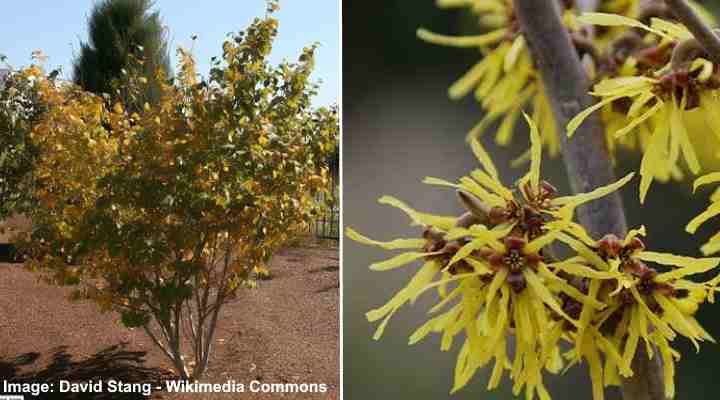
The common witch hazel is a deciduous shrub with distinctive, fragrant flowers with ribbon-like yellow petals. The medium- to large-sized shrubs bloom from late winter to early spring. The shrub can be identified by its small, sweet-smelling yellow flowers and oval green leaves. The leaves turn an attractive golden yellow in the fall.
The common witch hazel is low-maintenance and attracts various pollinators. The ribbon-like, bright yellow-orange petals also look attractive in mixed borders, rain gardens, or when grown as a hedge or specimen plant.
- Mature Size: 15 to 20 ft. (4.5 – 6 m) tall and wide
- USDA Zone: 3 to 8
- Sun Exposure: Full sun, partial shade, deep shade
- Soil Type: Organically rich, moist, well-drained soils, including heavy clay soil
Perforate St. John’s Wort (Hypericum perforatum)

The St. John’s Wort is a medium-sized shrub known for its bright yellow, star-shaped flowers. The small flowers have open petals with ribbon-like yellow stamens. These provide a striking contrast to the slender, lance-shaped leaves that cover the erect, green stems. This shrub blooms from early to late summer.
The St. John’s Wort is renowned for its medicinal properties. Landscaping ideas include planting in natural landscapes, borders, and ground cover. This plant is easy to care for, typically free from pests, and is a suitable choice for planting in a garden designed to deter deer.
- Mature Size: 1 to 3 ft. (0.3 – 1 m) and 1 to 2 ft. (0.3 – 0.6 m) wide
- USDA Zone: 3 to 8
- Sun Exposure: Full sun to partial shade
- Soil Type: Medium moisture soil that drains well
Japanese Barberry ‘Artropurpurea Nana’ (Berberis thunbergii ‘Artropurpurea Nana’)

The Japanese barberry is a small, deciduous shrub recognized for its reddish-purple foliage and thorn-covered branches. The magnificent compact shrub displays leaves that transform into vibrant hues of red during the autumn season. Additionally, in spring, small yellow blossoms emerge, contrasting beautifully with the reddish-purple foliage. During autumn, vibrant red berries persist on branches even after the foliage has fallen.
The Japanese barberry shrub grows 1 to 2 ft. (0.3 – 0.6 m) tall and spreads up to 3 ft. (1 m) wide. It is excellent for colorful ground cover, growing in mass in borders, or decorating a rock garden. This shrub is both drought- and pollution-tolerant.
- Mature Size: 1 to 2 ft. (0.3 – 0.6 m) and 2 to 3 ft. (0.6 – 1 m) wide
- USDA Zone: 4 to 8
- Sun Exposure: Full sun to partial shade
- Soil Type: Dry to medium, well-drained soil
Yellow Bells (Tecoma stans)

Yellow bells (Tecoma stans)
The yellow bells is a showy, fast-growing shrub with attractive clusters of large, yellow, trumpet-shaped flowers. This shrub flowers continuously from spring until late autumn. Other identifying features include bright green pinnate leaves, long arching stems, and narrow seed pods.
The yellow bells can grow as a large shrub or small tree, reaching heights of up to 25 ft. (8 m). The shrub can be pruned to help manage its height. This low-maintenance yellow shrub is perfect for enhancing garden borders, hedges, and containers with its attractive yellow blooms.
Yellow bells are native to the southwestern United States and are commonly grown in Florida, the Carolinas, and Texas.
- Mature Size: 10 to 25 ft. (3 – 8 m) tall and 10 to 20 ft. (3 – 6 m) wide
- USDA Zone: 9 to 11
- Sun Exposure: Full sun or partial shade
- Soil Type: Organically rich, well-drained soils with medium moisture
Golden Camellia (Camellia petelotii)

The golden camellia is a small shrub known for its attractive, cup-shaped yellow-orange blooms. Other identifying features of this evergreen shrub are its glossy dark green leaves, small seed capsules, and sweet scent. The golden camellia blooms from late winter until early spring.
The golden camellia grows up to 10 ft. (3 m) tall and performs best in dappled sunlight or partial shade. While not frequently cultivated, golden camellias can bring a delightful touch to gardens in warm climates. You have the option to either plant it individually as a standout specimen or utilize it to introduce a vibrant burst of color into mixed shrub borders or woodland gardens.
- Mature Size: Up to 6 to 10 ft. (1.8 – 3 m) tall and 6 ft. (1.8 m) wide
- USDA Zone: 8 to 10
- Sun Exposure: Dappled sunlight to partial shade
- Soil Type: Well-drained, acidic soil
Golden Trumpet (Allamanda cathartica)

The golden trumpet is a tropical, evergreen shrubby vine recognized for its vibrant, trumpet-shaped yellow flowers. The vibrant yellow blossoms create a striking contrast against the glossy, bright green leaves that measure 4 to 6 inches (10 – 15 cm) in length. Its trumpet-shaped flowers measure 5 inches (12 cm) across.
The golden trumpet blooms year-round in warm climates, attracting butterflies and hummingbirds with its scent. The robust climbing shrub can reach heights of up to 20 ft. (6 m) when exposed to sunlight or light shade. You also have the option to trim it or allow it to flourish on a trellis, arbor, or pergola.
- Mature Size: 10 to 20 ft. (3 – 6 m) tall and 3 to 6 ft. (1 – 1.8) wide
- USDA Zone: 10 and 11
- Sun Exposure: Full sun
- Soil Type: Well-drained fertile soil with lots of organic matter
Bush Allamanda (Allamanda schottii)
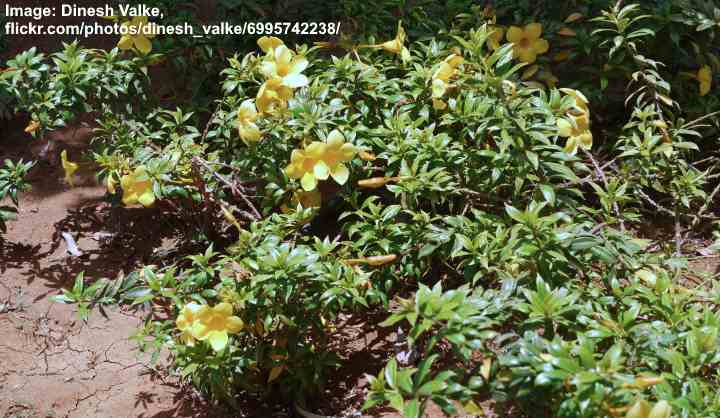
Bush Allamanda (Allamanda schottii)
The bush allamanda is a robust, fast-growing shrub known for its golden-yellow flowers. The flowers are characterized by their unique, reddish stripes in their throats. The shrub has lush, evergreen foliage consisting of leathery, oval-shaped leaves 2 to 4 inches (5 – 10 cm) long. Its yellow, trumpet-shaped flowers cover the shrub during summer.
The bush allamanda can reach up to 5 ft. (1.5 m) tall and is beloved in tropical gardens for its stunning colors. Landscaping ideas include planting as a hedge, specimen plant, or foundation plant in full sun. The nectar-rich flowers also attract hummingbirds and butterflies.
- Mature Size: 4 to 5 ft. (1.2 – 1.5 m) and wide
- USDA Zone: 10 and 11
- Sun Exposure: Full sun
- Soil Type: Organically rich, moist, fertile, well-drained soils
Yellow Flowering Weigela (Weigela middendorffiana)
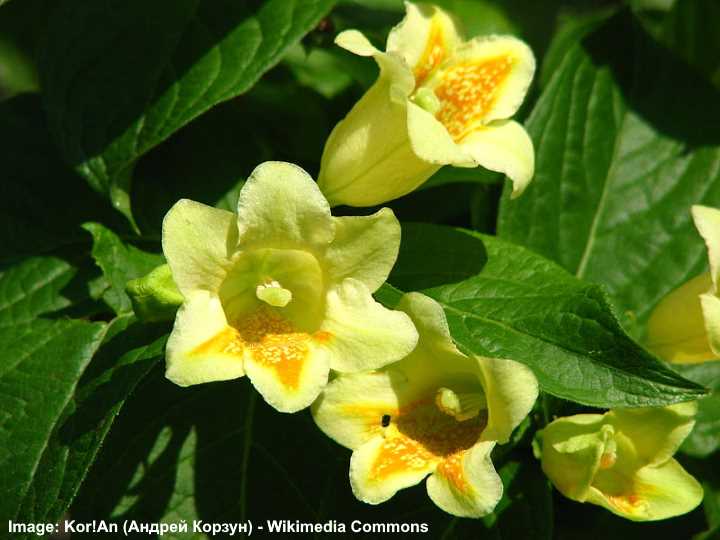
The yellow flowering weigela is a compact, deciduous shrub known for its beautiful pale-yellow, bell-shaped flowers. The flowers have distinctive orange markings in their throats. The shrub has oval-shaped, bright green leaves. The small yellow-flowering shrub grows up to 5 ft. (1.5 m) tall and wide.
This weigela shrub’s vibrant, nectar-rich yellow blooms attract bees and butterflies. The shrub performs well in garden landscapes as a border or a hedge. In addition, it is drought-tolerant once established and low-maintenance.
- Mature Size: 6 to 9 ft. (1.8 – 2.7 m) tall and wide
- USDA Zone: 4 to 8
- Sun Exposure: Full sun to partial shade
- Soil Type: Well-drained, moderately fertile soil
Yellow Jacobina (Justicia aurea)

The yellow Jacobina is an upright, evergreen shrub featuring distinctive yellow blooms. The floral clusters consist of arching, tubular-shaped yellow flowers arranged in an oval-shaped formation. The nectar-rich flowers bloom from midsummer until early fall, attracting pollinators such as butterflies and hummingbirds. The shrub has large, dark green, oval-shaped leaves, reaching up to 12 inches (30 cm) long.
In warm climates, the yellow Jacobina is an excellent choice for foundation planting or as a standout specimen plant. If your climate is on the cooler side, consider placing the shrub in containers to liven up a shaded patio or deck.
- Mature Size: 4 to 8 ft. (1.2 – 2.4 m)
- USDA Zone: 9 to 11
- Sun Exposure: Partial shade
- Soil Type: Humus-rich, well-drained soils that are consistently moist
Sweet Acacia (Vachellia farnesiana)

Texas Huisache (Sweet Acacia) (Vachellia farnesiana)
The sweet acacia is a large, thorny shrub known for its small, pom-pom-like yellow flowers. The beautiful shrub has medium-green, pinnately compound leaves on thorny, zig-zag-like stems. The sweet-smelling yellow blooms and delicate, fern-like leaves bring color and texture to any garden landscape.
The sweet acacia blooms in late winter, early spring, and sporadically throughout the summer. The sweet acacia is a well-liked decorative shrubby tree in Florida, California, and Texas due to its speedy growth and ability to thrive in humid, hot climates.
- Mature Size: 15 to 20 ft. (4.5 – 6 m)
- USDA Zone: 9 to 11
- Sun Exposure: Full sun or partial shade
- Soil Type: Loose, dry to medium moisture soils that have good drainage
Winter Jasmine (Jasminum nudiflorum)
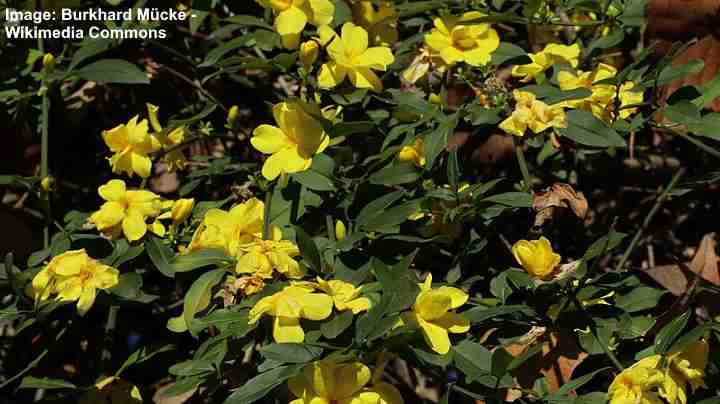
The winter jasmine is a medium-sized, deciduous shrub identified by its scentful, star-shaped yellow flowers. Other identifying features include long, arching branches, slender willow-like stems, and trifoliate leaves. The vining plant is versatile, serving as both ground cover and a cascading feature over retaining walls.
The winter jasmine, originally from China, can be found either as a shrub up to 4 ft. (1.2 m) or as a sprawling ground cover spreading up to 15 ft. (4.5 m) wide. Its curved branches can form a lovely waterfall of vibrant golden-yellow blossoms, bringing a burst of color to partially shaded outdoor spaces.
- Mature Size: 4 to 15 ft. (1.2 – 4.5 m) tall and 3 to 6 ft. (1 – 1.8 m) wide
- USDA Zone: 6 to 9
- Sun Exposure: Full sun or partial shade
- Soil Type: Humus-rich, well-drained soils that are consistently moist
Yellow Oleander (Cascabela thevetia)

The yellow oleander is an upright, tropical shrub featuring large, trumpet-shaped yellow flowers. The flowers bloom during the summer and fall. This upright shrub has willow-like, glossy green leaves and round, red-black fruits. The shrub grows up to 8 ft. (2.4 m) tall.
The yellow oleander is planted for its decorative appeal, either as a sizable shrub or a small tree. Its lush evergreen foliage and bright yellow flowers make it suitable as a hedge, privacy screen, accent tree, or foundation plant. Additionally, the shrub is drought- and heat-tolerant.
Be aware that the yellow oleander plant is toxic, and it should never be consumed. For this reason, it’s recommended not to plant it where children and pets play.
- Mature Size: 4 to 8 ft. (1.2 – 2.4 m) tall and 4 to 5 ft. (1.2 – 1.5 m) wide
- USDA Zone: 8 to 10
- Sun Exposure: Full sun or partial shade
- Soil Type: Rich, sandy soils that have excellent drainage
Carolina Yellow Jessamine (Gelsemium sempervirens)
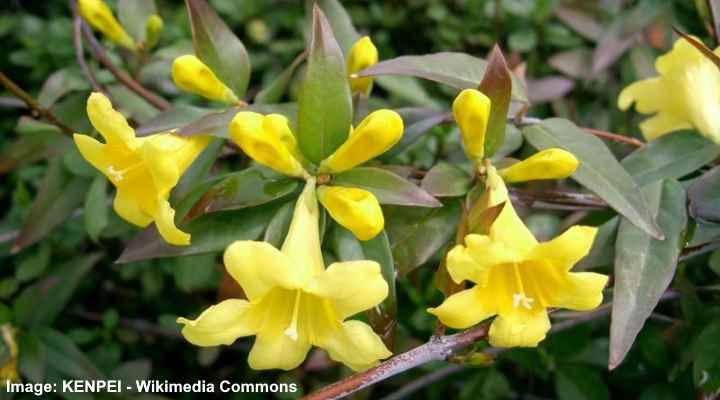
The yellow flowering Carolina jessamine is an evergreen vine that thrives in full sun but can tolerate light shade
The Carolina yellow jessamine is a vining, woody shrub known for its fragrant, trumpet-shaped yellow flowers. The bright, lemon-colored blossoms create an attractive contrast with the shiny, oval-shaped green leaves. The flowers are 1.5 inches (7.5 cm) in size, and its leaves range from 1 to 3 inches (2 to 7.5 cm) in length.
The Carolina yellow jessamine’s blossoms brighten up warm climates in late winter and early spring. The climbing vines sprawl across arbors, fences, and garden structures. If you want it to grow like a shrub, you can prune the vines. These delightful flowers draw in bees and butterflies, making them ideal for gardens that help pollinators.
- Mature Size: 10 to 20 ft. (3 – 6 m) tall and 3 to 6 ft. (1 – 1.8 m) wide
- USDA Zone: 7 to 10
- Sun Exposure: Full sun or partial shade
- Soil Type: Organically rich, moderately fertile soils with excellent drainage
Butterfly Bush ‘Honeycomb’ (Buddleja weyeriana ‘Honeycomb’)

The Butterfly Bush ‘Honeycomb’ is an ornamental, deciduous shrub identified by its clusters of fragrant, creamy yellow flowers. The flowers burst into bloom abundantly at the tips of arching branches. These cone-shaped flower clusters bloom abundantly from summer through fall. The shrub also has opposite, gray-green leaves, contrasting nicely with the honey-scented yellow blooms.
The yellow-flowering butterfly bush can reach a height of 7 ft. (2.1 m). It serves well in landscaping when planted in butterfly gardens, mixed borders, and cottage gardens.
- Mature Size: 5 to 7 ft. (1.5 – 2.1 m)
- USDA Zone: 5 to 9
- Sun Exposure: Full sun
- Soil Type: Medium moisture, well-drained soil
Orange Flowering Shrubs (with Pictures): Identification Guide
Below, you’ll find some attractive orange flowering shrubs for landscaping your garden:
Orange Hibiscus (Hibiscus rosa-sinensis)
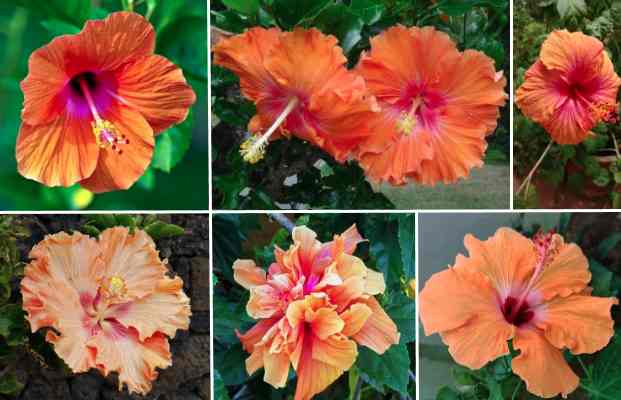
Orange Hibiscus (Hibiscus rosa-sinensis)
Orange hibiscus shrubs are a favored choice in garden landscapes because of their large, attractive, trumpet-shaped flowers. The stunning orange blooms can reach a width of 3 to 10 inches (7.5 to 25 centimeters). These vase-shaped shrubs bloom continuously from summer until fall.
Numerous dwarf hibiscus ornamental shrubs thrive in small, sunny gardens. These tropical hibiscus shrubs usually reach heights of 5 to 10 ft. (1.5 – 3 m). They are ideal for cultivating in USDA zones 10 and 11, making them perfect for tropical environments.
If you aim to cultivate hardy hibiscus shrubs and you live within USDA growing zones 4 to 9, you have numerous perennial flowering shrubs to consider. Although it’s important to note that hardy hibiscus plants do not produce orange blooms. Likewise, the widely favored rose of Sharon (Hibiscus syriacus) does not feature orange blossoms either.
- USDA Zones: 10 and 11
- Size: 5 to 10 ft. (1.5 – 3 m) tall
- Light Exposure: Full sun
- Soil: Moist, well-drained soil
Orange Bougainvillea
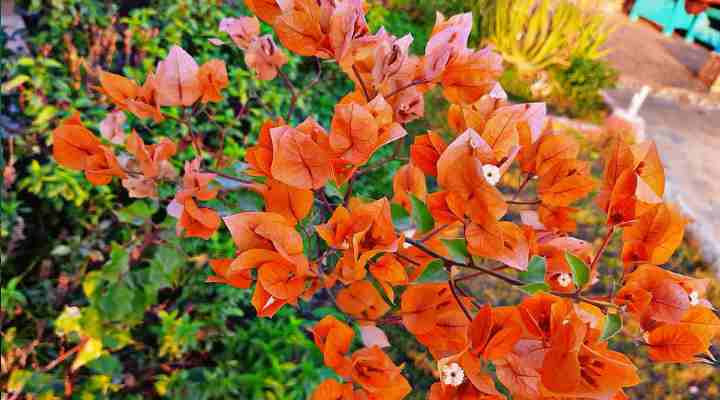
Orange Bougainvillea
Certain types of bougainvillea feature delightful orange flowers that cover the woody vine. The shrub’s blooms consist of paper-thin, orange bracts enveloping small, tubular orange flowers. This shrub, growing in sunny tropical climates, ensures yards are filled with lively orange shades year-round.
The bougainvillea is popular in Florida gardens, especially in zones 9 to 11. This trailing shrub is great for draping over walls, entrances, arbors, or covering trellises. Additionally, you can use the thorny shrub for foundation planting, privacy screens, or to enhance your landscape.
This prickly bush thrives in sunny spots and can reach heights of 8 to 40 ft. (2.4 – 12 m), spreading up to 30 ft. (9 m) wide.
In regions with mild weather, you can opt to raise bougainvillea in a hanging planter or maintain it as an indoor potted plant. This way, you can enjoy its charming orange blooms.
- USDA Zones: 9 to 11
- Size: 8 to 40 ft. (2.4 – 12 m) tall, 30 ft. (9 m) wide
- Light Exposure: Full sun
- Soil: Organically rich, well-drained soil
Darwin’s Barberry (Berberis darwinii)
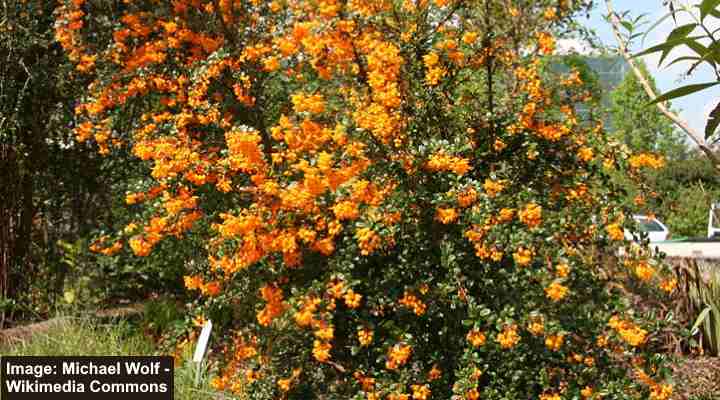
Darwin’s Barberry (Berberis darwinii)
The Darwin’s barberry is a spiny, evergreen shrub featuring showy, vibrant orange flowers. The flowers bloom in late winter and spring on hairy, red, thorny stems. The orange flowers bloom in elongated, drooping clusters that measure 5 inches (12 cm) across. Other identifying features include prickly, glossy green leaves and small, blue-purple berries.
The orange-flowering Darwin’s barberry reaches 5 to 10 ft. (1.5 – 3 m) tall and wide. This plant, with its sprawling, lush growth, does best in sunny spots or areas with light shade and well-drained soil. It’s suitable for growing in USDA zones 7 through 10.
The Darwin’s barberry is drought-tolerant and has plenty of attractive features. With its prickly red branches and holly-like leaves, it’s perfect for planting as a privacy plant, an evergreen hedge, or as a foundation plant. In addition, the showy orange buds and vibrant orange flowers make spring gardens come alive with color.
- USDA Zones: 7 to 10
- Size: 5 to 10 ft. (1.5 – 3 m) tall and wide
- Light Exposure: Full sun to partial shade
- Soil: Moist, well-drained soil
Orange Honeysuckle (Lonicera ciliosa)

Orange Honeysuckle (Lonicera ciliosa)
The orange honeysuckle is a deciduous, woody, shrubby vine with orange tubular flowers. The flowers bloom in late spring and early summer. These charming orange flowers are 1.5 inches (4 cm) long and feature five fused petals that separate and form curls at the ends. Other features include dark-green, ovate leaves and spherical, red fruits.
This orange honeysuckle, featuring vibrant orange flowers, can grow as tall as 20 ft. (6 m) and as wide as 30 ft. (9 m). The rapidly spreading shrub is excellent for draping over walls, trellises, and fences. Alternatively, you can allow the spreading stems to grow freely and create ground cover in sunny areas.
- USDA Zones: 5 to 9
- Size: 20 ft. (6 m) tall, 30 ft. (9 m) wide
- Light Exposure: Full sun to part shade
- Soil: Moist, well-drained soil
Cape Honeysuckle (Tecoma capensis)
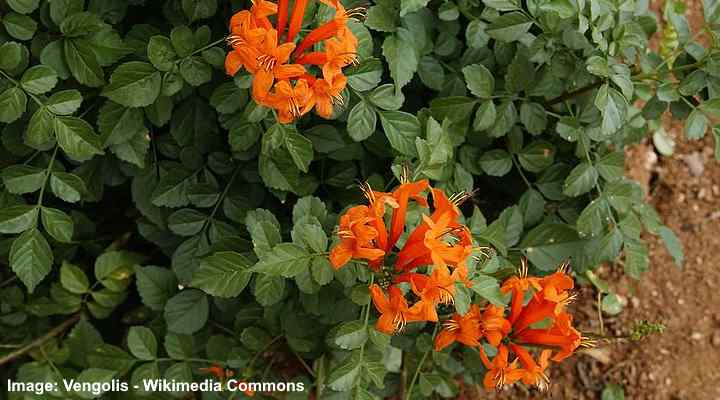
Cape Honeysuckle (Tecoma capensis)
The cape honeysuckle is a fast-growing, evergreen shrub or vine known for its brilliant orange trumpet-shaped flowers. The attractive flowers appear in dense clusters and are about 2 inches (5 cm) long, blooming from fall through spring. The scrambling shrub showcases compound leaves, which are dark green and composed of five to nine leaflets.
The cape honeysuckle can grow 7 to 10 ft. (2.1 – 3 m) tall. This rapid-growing plant, with its bushy and climbing stems, does well in both full sun and partial shade. This plant’s ability to tolerate drought, salt, and heat makes it a great choice for landscaping in coastal, arid, or heat-prone landscapes.
- USDA Zones: 9 to 11
- Size: 7 to 10 ft. (2.1 – 3 m) tall
- Light Exposure: Full sun to part shade
- Soil: Well-drained soil
Japanese Quince (Chaenomeles japonica)
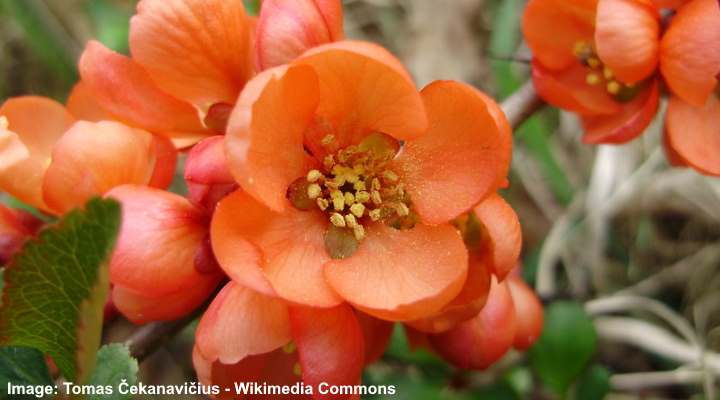
Japanese Quince (Chaenomeles japonica)
The Japanese quince is a thorny, deciduous shrub characterized by its clusters of small, red-orange flowers. The flowers grow along its thorny, widely spreading stems. Each flower is composed of five, orange-pink, round petals and yellow stamens. This compact shrub features lance-shaped leaves about 4 to 5 inches (10 to 13 cm) long as well as petite, greenish-yellow fruits.
The Japanese quince can be grown as a specimen plant, a low-growing flowering hedge, or planted along a foundation line. Grow the shrub in USDA zones 5 through 9.
- USDA Zones: 5 to 9
- Size: 3 ft. (1 m) tall, 6 ft. (1.8 m) wide
- Light Exposure: Full sun to partial shade
- Soil: Well-drained soil
Trumpet Vine (Campsis radicans)
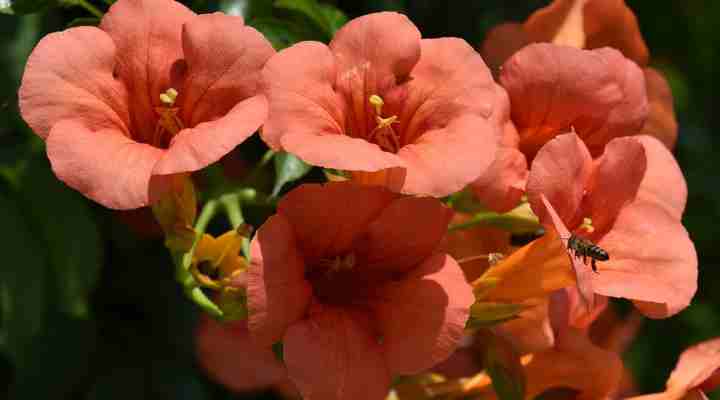
Trumpet Vine (Campsis radicans)
The trumpet vine, native to the eastern United States, is a climbing vine with orange, trumpet-shaped flowers. These delightful orange-red flowers appear throughout the summer, measuring 3 inches (8 cm) long. Other identifying features include bean-like seed pods and pinnately compound, dark green leaves that are 4 inches (10 cm) long.
The trumpet vine’s deep orange, funnel-shaped flowers bloom in groups of 4 to 12 at the ends of the branches. These persistent blooms attract pollinators and hummingbirds during summer. In USDA zones 5 to 9, this shrub-like vine can grow anywhere from 20 to 40 ft. (6 – 12 m) in height and up to 10 ft. (3 m) in width.
The trumpet vine is perfect for climbing fences or walls or as ground cover in sunny to partly shaded areas.
- USDA Zones: 5 to 9
- Size: 20 to 40 ft. (6 – 12 m) tall, 10 ft. (3 m) wide
- Light Exposure: Full sun to part shade
- Soil: Moist, well-drained soil
Common Lantana (Lantana camara)
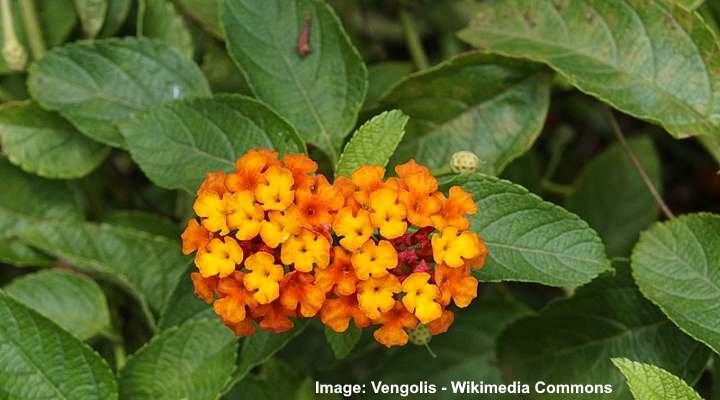
Common Lantana (Lantana camara)
Also known as the bigleaf lantana, the common lantana is an ornamental shrub renowned for its small orange flowers. The robust, drought-tolerant flowering plant has four-petaled yellow flowers arranged in spherical clusters. The colorful clusters come in flower combinations of pink and orange, red and orange, and yellow and orange.
The common lantana grows as a dense thicket. The eye-catching flower clusters are 2 inches (5 cm) wide, and the dark green leaves are oval and serrated, measuring 4 inches (10 cm) in length.
This orange-flowering shrub thrives in USDA zones 7 to 11 and reaches heights of 2 to 6 ft. (0.6 – 1.8 m) in warm areas. In places without frost, it sprawls horizontally and serves as a sun-loving ground cover.
- USDA Zones: 7 to 11
- Size: 2 to 6 ft. (0.6 – 1.8 m) tall
- Light Exposure: Full sun
- Soil: Slightly acidic, well-drained soil
Black-Eyed Clock Vine (Thunbergia alata)
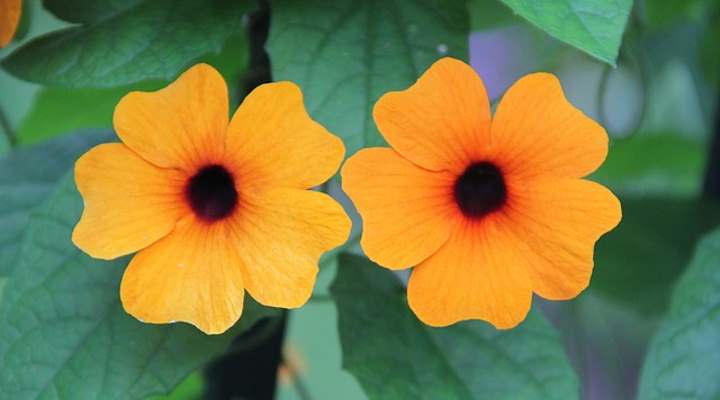
Thunbergia alata
The black-eyed clock vine is a fast-growing, spreading plant with five-petaled, orange flowers with black or dark brown throats. This orange vine is evergreen in tropical landscapes and blooms in the summer. The shrubby vine has soft, hairy, occasionally toothed leaves and grows 3 to 8 ft. (1 – 2.4 m) tall.
If you’re in USDA zones 10 or 11, you can grow the black-eyed clock vine in full sun to part shade. You can grow this vine over trellises, arbors, and fences. If you live in a moderate climate, consider cultivating the flowering plant in hanging baskets or as an indoor plant.
- USDA Zones: 10 and 11
- Size: 3 to 8 ft. (1 – 2.4 m) tall
- Light Exposure: Full sun to part shade
- Soil: Organically rich, well-drained soil
Marmalade Bush (Streptosolen jamesonii)
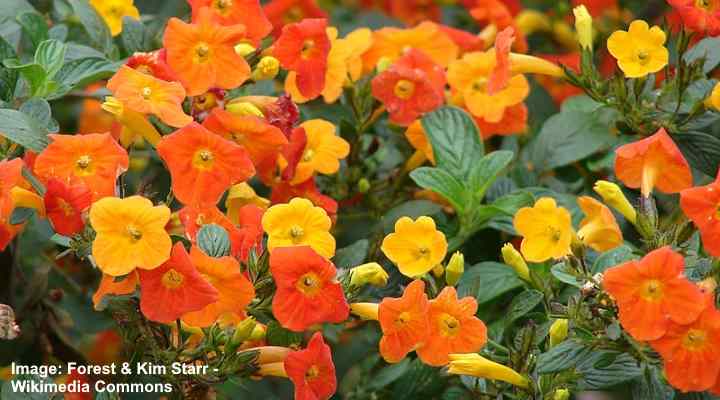
Marmalade Bush (Streptosolen jamesonii)
The marmalade bush is a beautiful, upright shrub known for its vibrant, funnel-like yellow or orange flowers. This climbing shrub features evergreen, oval-shaped, deep-green leaves. For sunny landscapes in USDA zones 10 and 11, consider growing this orange-flowering shrub.
One of the most eye-catching aspects of this shrub is when it becomes covered with large, 5 inch (13 cm) wide orange flowers. The small orange-flowering shrub grows 6 to 10 ft. (1.8 – 3 m) tall and up to 8 ft. (2.4 m) wide.
- USDA Zones: 10 and 11
- Size: 6 to 10 ft. (1.8 – 3 m) tall, 8 ft. (2.4 m) wide
- Light Exposure: Full sun
- Soil: Well-drained soil
Purple Flowering Shrubs (with Pictures): Identification Guide
Here are the most beautiful purple flowering shrubs for landscaping your garden:
Butterfly Bush (Buddleja)

Butterfly Bush (Buddleja)
The butterfly bush is known for its beautiful cone-shaped clusters of small purple flowers. These shrubs bloom in the middle of summer and keep their purple flowers until the first frost. The rounded shrub is covered with an abundance of stunning lilac-colored flowers, which not only attract butterflies but also emit delightful fragrances. This shrub grows between 5 and 10 ft. (1.5 – 3 m) tall.
The compact varieties of butterfly bushes are perfect for planting in small gardens. These lovely shrubs bloom with eye-catching, cone-shaped purple flowers. Butterfly bushes work well for foundation planting, growing in containers, cottage gardens, and perennial borders.
- USDA zone: 5 to 10
- Size: 5 and 10 ft. (1.5 – 3 m) tall
- Light Exposure: Full sun
- Soil: Well-drained soil
Bluebeard (Caryopteris x clandonensis)
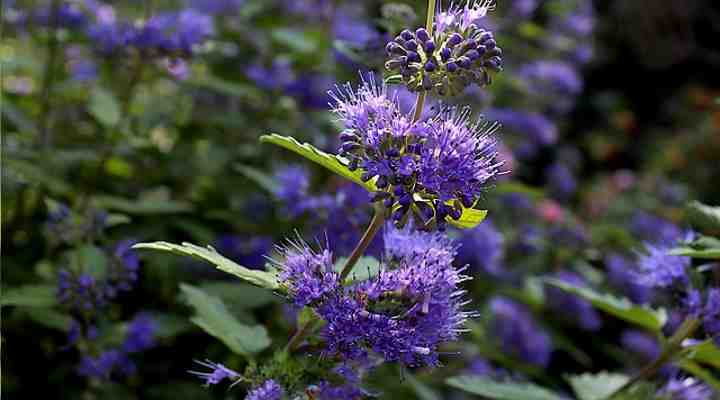
The small bluebeard shrub has purple/blue flowers that add decorative touch to front of backyard
The bluebeard is a compact, rounded shrub identified by its small, purple flowers on upright stems and gray-green, serrated leaves. The purple flowers blossom in late summer and early autumn, filling the garden air with pleasant aromas.
Bluebeard shrubs thrive in USDA zones 6 to 9 in well-drained soil. The purple shrub makes an excellent low-maintenance addition to front gardens, perennial borders, butterfly gardens, or containers, thanks to its drought tolerance.
- USDA zone: 6 to 9
- Size: 2 to 3 ft. (0.6 – 1 m) tall
- Light Exposure: Full sun
- Soil: Well-drained soil
Common Lilac (Syringa vulgaris)

Lilac Shrubs (Syringa vulgaris)
The common lilac is an upright, rounded shrub that produces clusters of purple, violet, lavender, rose, magenta, and lilac-colored flowers. These large, funnel-like flower clusters can grow as long as 8 inches (20 cm) and release a strong scent. Lilacs bloom for about four weeks during the late spring season.
Common lilacs typically grow 8 to 15 ft. (2.4 – 4.5 m) tall and wide. For compact yards, choose dwarf lilacs that won’t exceed 4 ft. (1.2 m) in height. A benefit of growing lilac shrubs is that they are cold-hardy to zone 3 and adaptable to most soil types.
The common lilac can be grown as a deciduous hedgerow, specimen plant, or privacy screen in the summer.
- USDA zone: 3 to 7
- Size: 8 to 15 ft. (2.4 – 4.5 m) tall and wide
- Light Exposure: Full sun
- Soil: Fertile, humus-rich, well-drained soil
Purple Flowering Jane Magnolia (Magnolia liliiflora x Magnolia stellata)
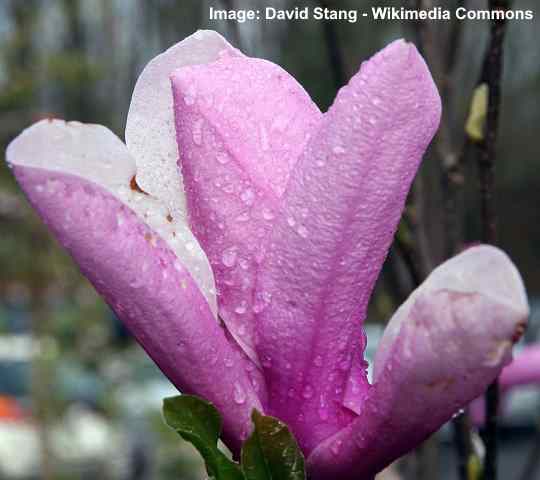
The Jane magnolia is a slow-growing shrub or small tree identified by its fragrant, cup-shaped purple-pink flowers.
The Jane magnolia’s fragrant, purple-pink, tulip-like flowers grow up to 8 inches (20 cm) wide. The shrub’s foliage is composed of 6-inch (15-cm) long, oval-shaped, glossy green leaves.
The small Jane magnolia bush reaches 10 to 15 ft. (3 – 4.5 m) tall. It thrives in USDA zones 4 – 8 in full sun to part shade.
“The Little Girl Series” includes the Jane magnolia, which is a hybrid of Magnolia liliiflora and Magnolia stellata. In the same series, you can find magnolias like ‘Susan’ with purplish-red blossoms and ‘Ann’ with deep-purple, pink flowers.
- USDA zone: 4 to 8
- Size: 10 and 15 ft. (3 – 4.5 m) tall
- Light Exposure: Full sun to partial shade
- Soil: Moist, well-drained soil
Lavender (Lavandula spp.)

Lavender (Lavandula angustifolia)
Lavender is a small shrub or herbaceous plant known for its small spikes of fragrant purple flowers. These tall flower clusters showcase colors that span from violet to lilac, light blue, or dark purple. Also known as the common lavender, this woody perennial usually has a clump-like growth habit.
Lavenders are low-maintenance, year-round-blooming shrubs that prefer sunny locations with good soil drainage. While lavender plants with purple blooms are the most widespread, there are also lavender varieties featuring white flowers, known as Lavandula angustifolia ‘Nana Alba,’ and lavenders with pink blossoms, referred to as Lavandula angustifolia ‘Rosea.’
- USDA zone: 5 to 9
- Size: 2 to 3 ft. (0.6 – 1 m) tall
- Light Exposure: Full sun
- Soil: Well-drained soil
Golden Dewdrops (Duranta erecta)
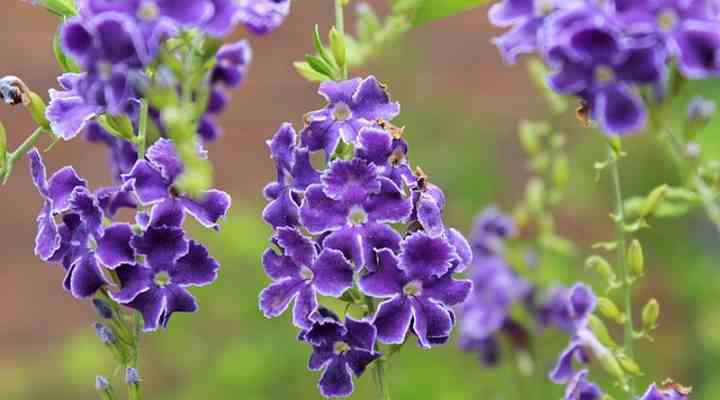
Golden Dewdrops (Duranta erecta)
The golden dewdrops is a fast-growing evergreen shrub known for its beautiful clusters of purple and white flowers. These blooms are star-shaped and composed of five purple petals with light edges. The dangling panicles on the gracefully arched stems can measure up to 6 inches (15 cm) long and emit a pleasant, vanilla-like fragrance.
The golden dewdrops grows as an evergreen, decorative shrub in subtropical climates. If you’re in a temperate climate, consider planting this impressive shrub in a container and overwinter it indoors, or simply grow it for a single season.
The golden dewdrops will produce orange berries after the flowers fade. Although birds enjoy consuming them, be aware that the berries are extremely poisonous to humans and animals.
- USDA zone: 10 and 11
- Size: 10 to 20 ft. (3 – 6 m) tall
- Light Exposure: Full sun
- Soil: Moist, well-drained, fertile soil
Winter Heath (Erica x darleyensis)
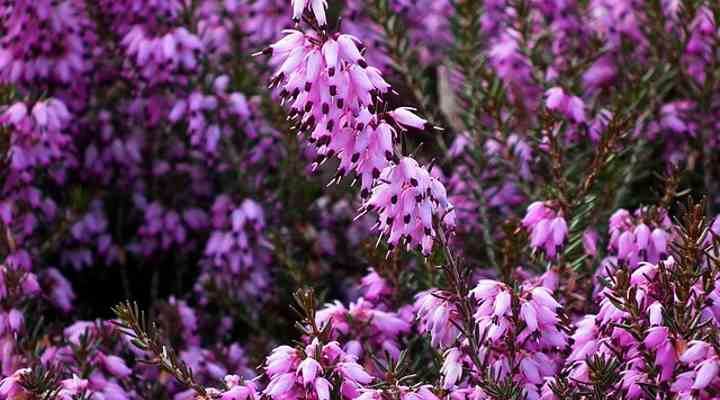
The ornamental small winter heath shrub is grown for its evergreen foliage and purple flowers
The winter heath is an evergreen, woody shrub known for its clusters of urn-shaped pink flowers. Growing up to around 18 inches (45 cm) tall, it can also be identified by its dark green, thin, needle-like leaves growing on upright stems. Tiny bell-shaped flowers, in either light purple or deep pink hues, line the entire stem, creating a striking contrast with the rich green foliage.
The winter heath blooms in late winter to early spring. The stunning evergreen leaves and soft purple or pink blooms create a vivid contrast against the snowy backdrop, adding color to an otherwise desolate landscape.
- USDA zone: 6 to 9
- Size: 1.5 ft. (0.4 m) tall
- Light Exposure: Full sun
- Soil: Well-drained soil
Russian Sage (Salvia yangii)

Russian Sage (Salvia yangii)
The Russian sage is a small, upright herbaceous shrub with sturdy, thin stems covered with lavender-blue flowers. These flowers, ranging from blue to violet, bloom from mid-summer through late fall. The collection of wispy stems produces a faint, purplish effect in summer landscapes.
The Russian sage features gray-green leaves that produce a sage-like aroma when crushed. This shrub grows 1.6 to 4 ft. (0.5 – 1.2 m) tall.
The Russian sage can be grown as a deciduous perennial in shrub borders, along driveways, and in containers. Additionally, the violet lavender blossoms stay on the shrub even during periods of drought, rendering it an excellent choice for xeriscaping.
- USDA zone: 3 to 9
- Size: 1.6 to 4 ft. (0.5 – 1.2 m) tall
- Light Exposure: Full sun
- Soil: Well-drained soil
Chaste Tree (Vitex agnus-castus)

The chaste tree is an ornamental, deciduous shrub native to the Mediterranean region. The shrub is characterized by its attractive, upright clusters of fragrant purple flowers. In early summer, the shrub’s spreading, vase-shaped canopy is covered with lilac flower clusters. Other identifying features include round, purple-black fruits and aromatic, grayish-green leaves.
The chaste tree is additionally referred to by other names, such as the monk’s pepper or lilac chaste tree. Thanks to its plentiful foliage and appealing blossoms, this shrub is certain to boost the attractiveness of any outdoor setting.
Landscape ideas for the chaste tree include adding it to shrub borders, growing it as a foundation plant, or showcasing it as a unique focal point. In the summer season, the pleasing scent of its violet blooms attracts butterflies, bees, and various other pollinators.
- USDA zone: 6 to 9
- Size: 4 to 15 ft. (1.2 – 4.5 m) tall and wide
- Light Exposure: Full sun
- Soil: Well-drained soil
Clematis ‘Betty Corning’

The Clematis ‘Betty Corning’ is a medium-sized vining shrub with fragrant, purple-lavender bell-shaped flowers. The shrub’s blooming period lasts from midsummer until fall. The shrub also has pinnate leaves divided into dark green pinnate leaves. The foliage creates an attractive contrast with the purple blooms.
The Clematis ‘Betty Corning’ can be trained to climb a wall, trellis, or archway. The shrub’s vivid purple flowers and lush evergreen foliage are sure to add a touch of beauty to any garden.
- USDA zone: 4 to 9
- Size: 6 ft. (1.8 m) tall
- Light Exposure: Full sun to partial shade
- Soil: Moist, well-drained soil
Rosa ‘Poseidon’

The Rosa ‘Poseidon’ is a compact, upright shrub featuring charming pale-purple blooms adorned with as many as 60 delicate petals. The shrub showcases glossy, light green foliage with serrated edges and a bushy, spreading growth pattern. Due to its small size, it is a great option for planting as an ornamental shrub. Additional landscaping options include incorporating it within a border or planting it at the front of house.
- USDA zone: 5 to 10
- Size: 3 to 4 ft. (0.9 – 1.2 m) tall
- Light Exposure: Full sun
- Soil: Well-drained soil
Heliotrope (Heliotropium arborescens)
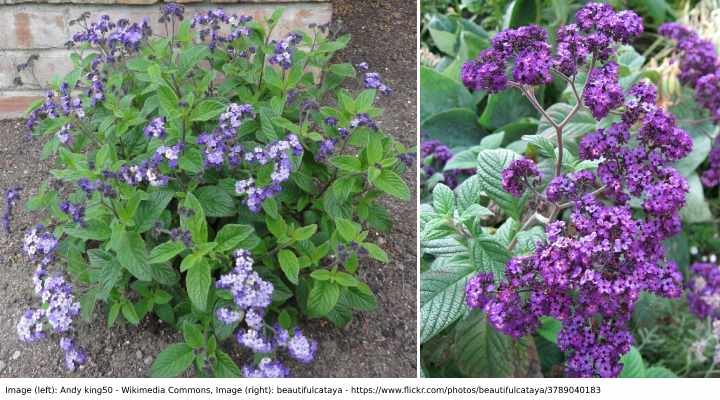
The heliotrope is an upright evergreen shrub characterized by its attractive, small purple flowers. The blossoms emerge in dense, rounded clusters and emit a sweet, vanilla-like fragrance. This shrub produces flowers from summer through autumn. It also has rough, ovular, dark green leaves. This shrub is primarily cultivated as a potted plant. It’s important to remember that the shrub must be brought indoors during the winter months in zones 9 and lower.
- USDA zone: 9 to 11
- Size: 2 to 6 ft. (0.6 to 1.8 m) tall, 6 to 8 ft. (1.8 to 2.4 m) wide
- Light Exposure: Full sun
- Soil: Organically rich, moist, well-drained soil
Clematis

clematis
Clematis is a group of flowering vines, and a subset can be cultivated to grow in a shrub-like form with purple flowers. Herbaceous clematis is a clump-forming perennial with flowers and foliage that resemble climbing varieties. During summer and autumn, the shrub features bell-shaped flowers with four or five curled purple or blue petals.
When clematis doesn’t climb, it tends to stay short, typically growing to a height of 1 to 8 ft. (0.6 to 2.5 m) and a width of up to 3 ft. (1 m). These woody shrubs follow a seasonal pattern: they fade away in late fall and make a comeback in spring to flower in early summer. Make sure to plant the clematis in full sun for the prettiest blooms.
- USDA zone: 4 to 9
- Size: 1 and 8 ft. (0.6 and 2.5 m) tall, 3 ft. (1 m) wide
- Light Exposure: Full sun
- Soil: Fertile, moist, well-drained soil
Purple Crape Myrtle Bushes (Lagerstroemia indica)
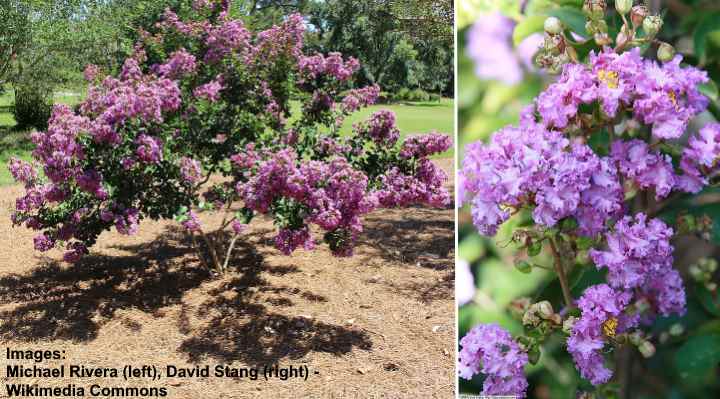
Catawba Crape Myrtle
The crape myrtle is a medium-sized deciduous shrub featuring large, paper-like purple flowers. Other identifying features include a broad, spreading crown, leathery, dark green leaves, and cinnamon-colored bark. In autumn, the leaves turn a delightful orange-red hue. The purple flowers bloom in late summer and persist until autumn.
Crape myrtle shrubs come in numerous types. Certain compact varieties reach heights of 2 to 4 ft. (0.6 to 1.2 m), while larger ones can grow anywhere from 5 to 15 ft. (1.5 to 4.5 m) in height and spread up to 10 ft. (3 m) in width.
Some varieties of crape myrtle shrubs with purple flowers include Catawba Crape Myrtle (Lagerstroemia indica ‘Catawba’), ‘Early Bird Purple,’ ‘Early Bird Lavender,’ and ‘Purple Magic.’
- USDA zone: 6 to 10
- Size: 5 to 15 ft. (1.5 – 4.5 m) tall, 10 ft. (3 m) wide
- Light Exposure: Full sun
- Soil: Slightly acidic, well-drained soil
White Flowering Shrubs (with Pictures): Identification Guide
Below you’ll find some beautiful white flowering shrubs to consider planting in your garden:
White Lilac Bushes (Syringa vulgaris)

White Lilac Bushes (Syringa vulgaris)
Lilac bushes are hardy, multi-stemmed shrubs known for their cone-shaped clusters of purple, pink, or white blooms. When the shrub blooms, it produces many long, scentful, white panicles that envelop the large shrub. The panicles grow up to 8 inches (20 cm) long.
Lilac shrubs with white blossoms reach heights ranging from 8 to 15 ft. (2.4 to 4.5 m) and can spread up to 12 ft. (3.6 m). Large lilac shrubs are great options for establishing summer privacy screens or hedges. For small gardens or containers, consider planting beautiful, pure white blossoms of dwarf lilac varieties.
- USDA zone: 3 to 7
- Size: 8 and 15 ft. (2.4 – 4.5 m) tall, 12 ft. (3.6 m) wide
- Light Exposure: Full sun
- Soil: Humus-rich, fertile, well-drained soil
Cherry Laurel (Prunus laurocerasus)

Cherry Laurel (Prunus laurocerasus)
The cherry laurel, an evergreen shrub, features delicate white blossoms that emit a lovely fragrance and cluster together in 4-inch (12-cm) long racemes. The eye-catching, spring-blooming flowers give off a plum-like scent. The shrub has leathery, dark green, lance-shaped leaves that grow densely on branches. It also grows clusters of small, red-black berries that add plenty of visual interest in winter.
The cherry laurel shrub is fast-growing and reaches a mature height of between 10 and 20 ft. (3 – 6 m) and a spread of 11 ft. (3.3 m). The shrub’s dense, bushy foliage makes it a top choice for flowering hedges, screens, or distinctive specimen plants.
- USDA zone: 6 to 9
- Size: 10 and 20 ft. (3 – 6 m) tall, 11 ft. (3.3 m) wide
- Light Exposure: Full sun to partial shade
- Soil: Organically rich, moist, well-drained soil
False Holly (Osmanthus heterophyllus)

False holly Osmanthus heterophyllus
The false holly is a bushy, rounded evergreen shrub identified by its clusters of small, fragrant white flowers. The white blossoms create a stunning contrast with the shrub’s glossy green, serrated leaves. The name of this mounding holly-like shrub comes from its evergreen, spiky foliage. The fragrant flowers of this shrub bloom in autumn and last until early winter.
The false holly is an ideal shrub choice for foundation plantings, security hedges, or the creation of a year-round privacy screen. This sizable shrub reaches a height of 6 to 21 ft. (1.8 to 6.4 m) and spans a width of 5 to 10 ft. (1.5 to 3 m).
- USDA zone: 6 to 9
- Size: 21 ft. (1.8 – 6.4 m) tall, 5 to 10 ft. (1.5 – 3 m) wide
- Light Exposure: Full sun to partial shade
- Soil: Organically rich, well-drained soil
Japanese Aralia (Fatsia japonica)
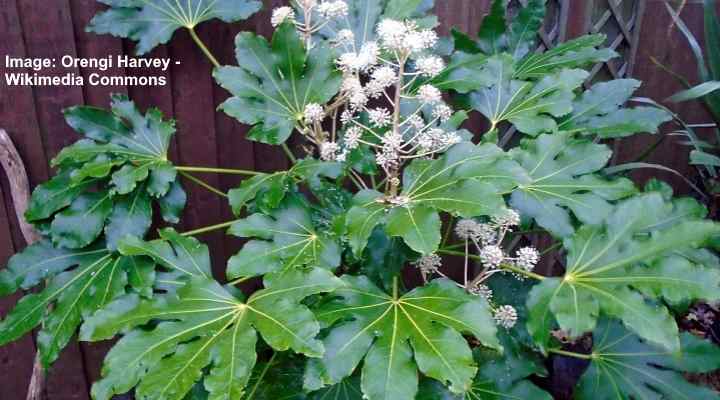
Japanese Aralia (Fatsia japonica)
The Japanese aralia is an ornamental shrub identified by its large, palm-like, leathery green leaves. Other identifying features include long, arching stems and spherical, creamy-white flowers. Japanese aralia flowers form petite, spherical clusters that are about 1 inch (2.5 cm) in diameter. One benefit of this ornamental shrub is its ability to thrive in shaded garden areas.
The Japanese aralia’s tropical foliage and globe-shaped flowers form a spectacular, rounded growth. The Japanese aralia reaches a height of 6 to 19 ft. (1.8 – 5.7 m) and a width of 4 to 6 ft. (1.2 – 1.8 m). In addition to being suitable for ground planting, the Japanese aralia can also be grown in pots or suspended baskets.
- USDA zone: 7 to 10
- Size: 6 to 19 ft. (1.8 – 5.7 m) tall, 4 to 6 ft. (1.2 – 1.8 m) wide
- Light Exposure: Full sun to shade
- Soil: Fertile, moist, well-drained soil
Red Twig Dogwood Shrubs (Cornus alba)

Cornus alba flowers and leaves
The red twig dogwood is an attractive spreading shrub identified by its creamy yellow blossoms, dark green ovular leaves, and distinctive red stems. This rapidly-growing ornamental shrub is well-known for its clusters of flat-topped, tiny white flowers.
Red twig dogwood shrubs provide year-round beauty. In spring and summer, the shrub is covered with showy, yellow-green, ovular leaves and white flowers. In autumn, the leaves turn spectacular purple, red, and burgundy hues. Then, bright red stems provide extra visual appeal in winter.
When it comes to landscaping, dogwood shrubs are excellent choices for accent, border, or flowering hedge plants. These shrubs should be planted in full sun for the most vigorous blooming. Dogwood shrubs grow 8 to 10 ft. (2.4 – 3 m) tall and up to 10 ft. (3 m) wide.
- USDA zone: 3 to 7
- Size: 8 to 10 ft. (2.4 – 3 m) tall, 10 ft. (3 m) wide
- Light Exposure: Full sun
- Soil: Moist, damp soil
Winter Daphne (Daphne Odora ‘Alba’)
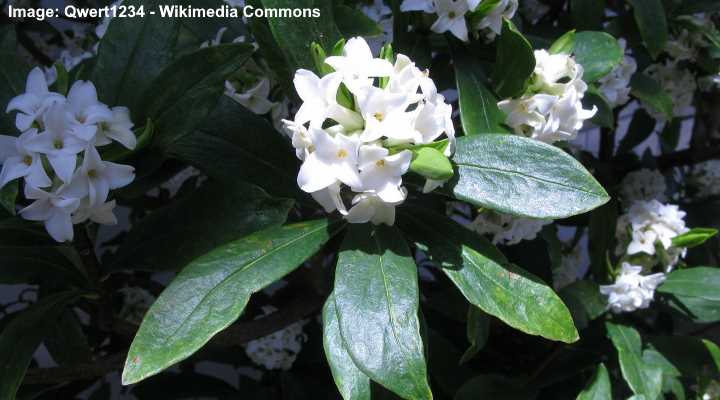
Winter Daphne (Daphne Odora ‘Alba’)
The winter daphne ‘alba’ is a compact evergreen shrub known for its sweet-smelling white flowers. The shrub’s creamy white blooms grow in tightly packed, globe-shaped clusters. The shrub blooms from late winter until early spring. Another appealing feature of these evergreen shrubs is their glossy green, pointed, oblong leaves.
The winter daphne ‘alba’ grows 3 to 6 ft. (1 – 1.8 m) tall and around 4 ft. (1.2 m) wide. For the most favorable results, ensure full sun exposure and moist, well-drained soil.
‘Aureomarginata Alba’ is another lovely white-flowering variety of Daphne odora, featuring glossy, dark green leaves accented by white margins.
- USDA zone: 7 to 9
- Size: 3 and 6 ft. (1 – 1.8 m), 4 ft. (1.2 m) wide
- Light Exposure: Full sun
- Soil: Well-drained, moist soil
Hummingbird Summersweet (Clethra alnifolia)
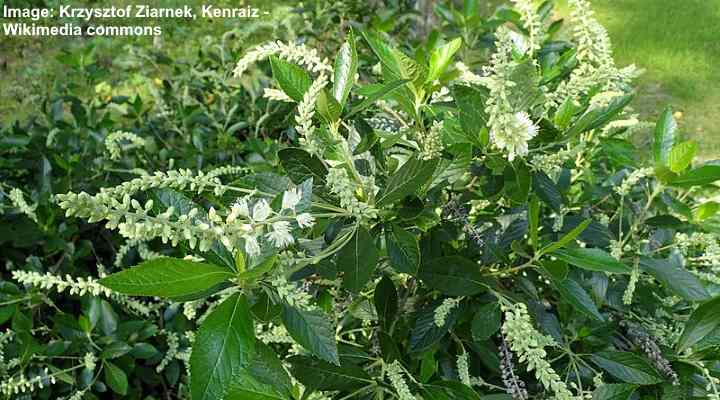
Clethra alnifolia ‘Hummingbird’ is a compact white flowering shrub that is suitable for both sunny and shady locations
The hummingbird summersweet is a hardy deciduous shrub known for its long white flower spikes. The fragrant conical clusters reach between 3 to 6 inches (7.5 – 15 cm) long. The small, cup-shaped white flowers bloom in June and July. Additionally, the shrub’s glossy-green oval-shaped leaves turn a yellow hue in the fall.
The hummingbird summersweet forms mounding clumps that reach heights of 5 to 10 ft. (1.5 to 3 m). Unlike many other flowering shrubs, the summersweet’s creamy-white flowers flourish in both shade and full sun.
- USDA zone: 3 to 9
- Size: 5 and 10 ft. (1.5 – 3 m) tall
- Light Exposure: Full sun to shade
- Soil: Moist, well-drained soil
Virginia Sweetspire (Itea virginica)
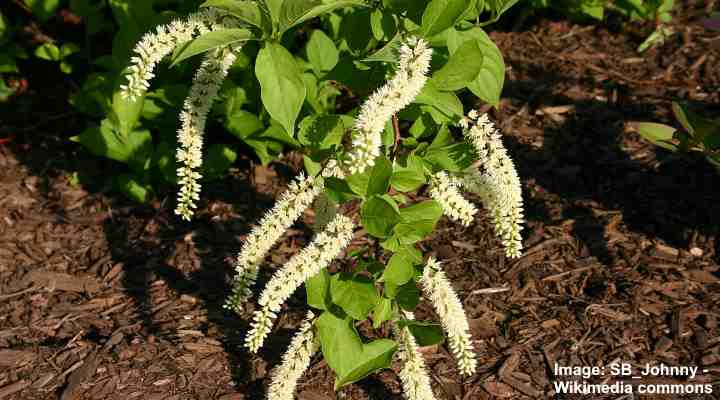
The low growing sweetspire shrub is great for landscaping compact spaces
The Virginia sweetspire is a small, upright shrub identified by long, cylindrical clusters of white flower spikes. The fragrant, arching racemes measure 3 to 6 inches (7.5 – 15 cm) in length. This low-maintenance deciduous shrub has alternate, dark green, lance-shaped leaves. The leaves turn a wonderful shade of orange-red in autumn.
The Virginia sweetspire is a multi-stemmed shrub that develops into dense bushes, typically ranging from 3 to 10 ft. (1 to 3 m) tall. The abundant foliage and white flowers are perfect for shrub borders, hedges, or foundation plantings. It’s a good choice for planting near ponds due to its ability to thrive in damp soil.
- USDA zone: 5 to 9
- Size: 3 to 10 ft. (1 – 3 m) tall
- Light Exposure: Full sun
- Soil: Moist, well-drained soil
Wine Ninebark (Physocarpus opulifolius)
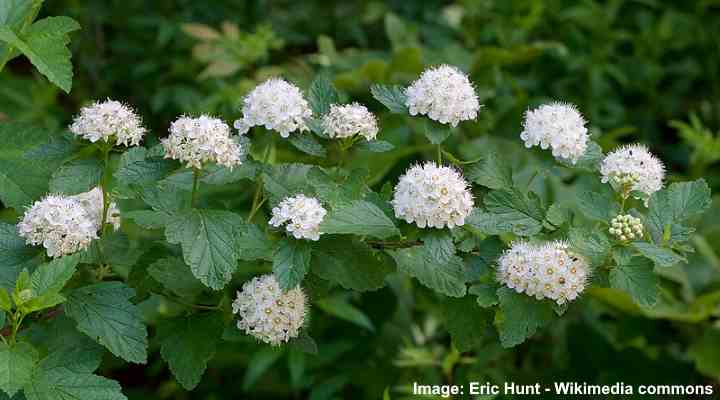
The compact growth of dwarf ninebark shrub is great in rock gardens or at the front of flower beds
The wine ninebark is a fast-growing, upright shrub known for its abundant, creamy white flowers growing in flat-topped clusters. Attractive, round spring blossoms typically come in soft white-pink hues and measure 1 to 3 inches (2.5 to 7.5 cm). The shrub has alternate, large, oval-shaped leaves that turn golden yellow in the fall.
The wine ninebark is great for growing in mass plantings, flowering hedges, borders, or barriers. This plant’s ability to withstand drought, shade, sun, and poor soil makes it a valuable landscaping option. This shrub typically grows to a height of 8 ft. (2.4 m), but the ‘Nana’ dwarf variety is suitable for containers and reaches only 1 to 2 ft. (0.3 to 0.6 m).
- USDA zone: 2 to 8
- Size: 8 ft. (2.4 m) tall
- Light Exposure: Full sun
- Soil: Moist, well-drained soil
Red Flowering Shrubs (with Pictures): Identification Guide
Here are the most beautiful red flowering shrubs for landscaping your garden:
Red-Flowering Chinese Quince (Chaenomeles speciosa)
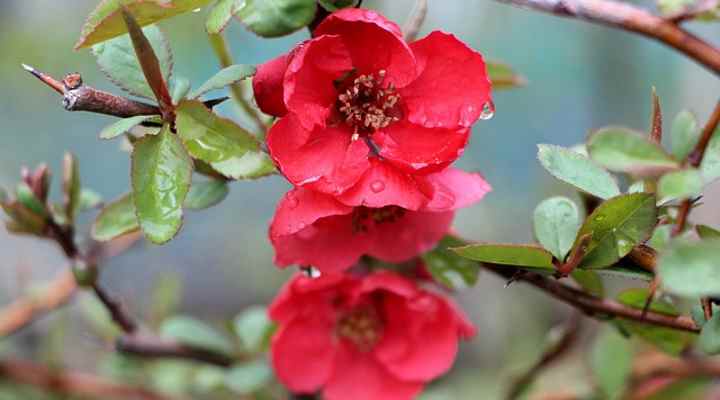
The thorny Chinese quince bush is a decorative spiky plant with attractive flowers and edible fruit
The Chinese quince is a deciduous, woody shrub recognized by its cup-shaped red flowers. The shrub’s lovely, spring-blooming red blooms take on an open, bowl-like shape and are composed of five papery petals. Other identifying features of this thorny shrub include alternate, oval-shaped, dark green leaves and round fruits. The fruits ripen by early fall after the blooming period.
The Chinese quince’s showy red flowers appear in small clusters of two to four on the shrub. Typically, the dainty flowers span about 1.6 inches (4 cm) in width. The shrub becomes a vibrant display of crimson-red colors due to the red flower clusters.
The red-flowering Chinese quince stands at a height of 4 to 5 ft. (1.2 to 1.5 m) and can reach a width of 8 ft. (2.4 m). This attractive shrub is perfect for serving as a deciduous flowering hedge, a specimen plant, a foundation plant, or for training against a wall.
Quince fruits, while edible, are notably bitter. Despite this, they are a favored ingredient for producing jellies and preserves.
- USDA zone: 5 to 9
- Size: 4 to 5 ft. (1.2 – 1.5 m) tall, 8 ft. (2.4 m) wide
- Light Exposure: Full sun
- Soil: Well-drained soil
Dwarf Spirea Shrubs (Spiraea japonica)
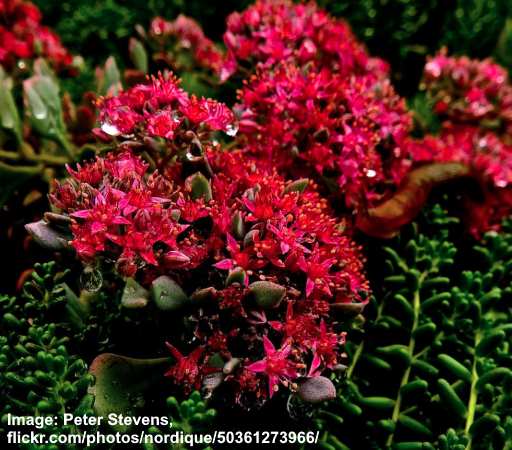
red spirea
Some varieties of dwarf spirea shrubs produce umbrella-shaped clusters of burgundy-red flowers. The red spirea flowers start to bloom in spring and develop into a more vivid red shade as the summer months roll in. The aromatic red flowers beautifully contrast against the dark green foliage.
Although most spirea shrubs have white or pink blossoms, the red cultivars enhance the landscape with a striking burst of color.
The red-flowering dwarf shrubs reach 2 to 3 ft. (0.6 – 1 m) tall and wide. Although long-lasting flowering shrubs are excellent for front-of-house landscaping, you can also cultivate them in borders, hedges, or as a distinctive standalone plant in full sunlight. In addition, the shrubs are an excellent choice for deer-resistant gardens.
- USDA zone: 3 to 8
- Size: 2 to 3 ft. (0.6 – 1 m) tall and wide
- Light Exposure: Full sun
- Soil: Moist, well-drained soil
Red Bottlebrush Shrub (Callistemon)
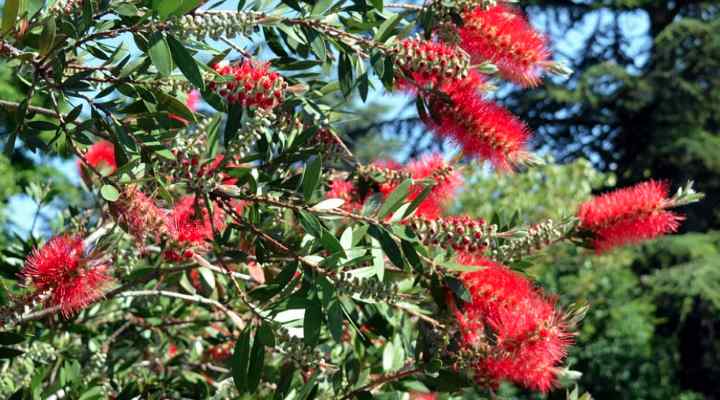
red bottlebush
The red flowering bottlebrush is known for its unique red flowers that resemble a bottle-cleaning brush. The evergreen, drought-tolerant shrub is characterized by its arching branches, lance-shaped leaves, and red blossoms that emit a citrusy aroma. The sizable shrub or compact flowering tree can reach heights ranging from 3 to 25 ft. (1 to 7.5 m).
Red bottlebrush shrubs are evergreen, year-round blooming plants that flourish in warm climates. In addition to the appealing, aromatic red bottlebrush flowers, the shrub features lanceolate leaves and a profusion of woody seed pods.
In colder zones, the red bottlebrush takes on the form of a small shrub, measuring 3 to 5 ft. (1 to 1.5 m) tall. The red-flowering shrub is excellent for growing in containers. Alternatively, you can grow it as a hedge, wall-side border, or foundation plant. In warmer regions, the sizable shrub has the potential to reach heights of up to 25 ft. (7.5 m) in the form of a petite tree.
- USDA zone: 10 to 11
- Size: 3 and 25 ft. (1 – 7.5 m) tall
- Light Exposure: Full sun
- Soil: Moist, well-drained soil
Red Flowering Maple Shrub (Abution)
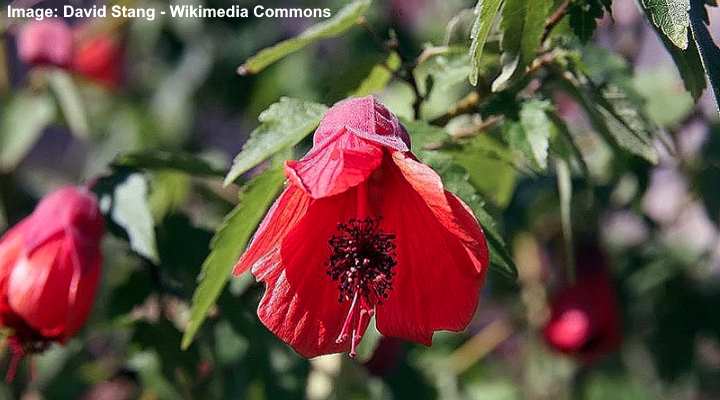
Red Abutilon
The red-flowering maple shrub is a low-growing, woody plant known for its vivid red, bell-shaped flowers. The charming red-flowering shrub blooms from the onset of summer until the arrival of the first frost. The sun-loving shrub features maple-like, palmate foliage found on arching branches.
The small, red-flowering maple shrub grows best in full sun to partial shade. Despite this, it must be grown in an area without frost. Due to its pendulous growth habit and appealing red blooms, the shrub is perfect for planting in suspended baskets or containers.
- USDA zone: 8 to 10
- Size: 1 ft. (30 cm)
- Light Exposure: Full sun to partial shade
- Soil: Rich, well-drained soil
Red Buckeye Shrub (Aesculus pavia)
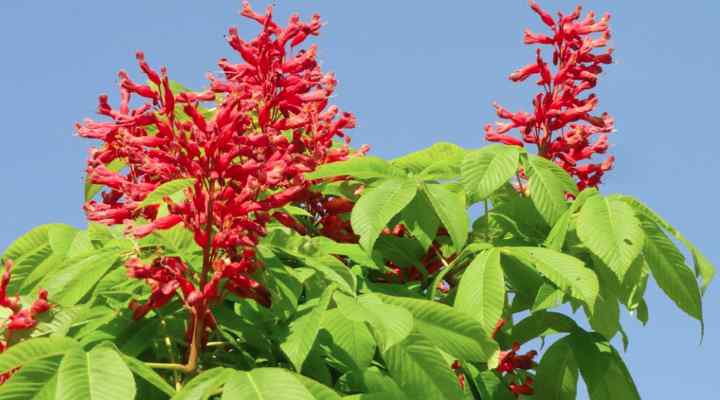
Red Buckeye Shrub (Aesculus pavia)
The red buckeye is a large deciduous shrub identified by its red flowers that bloom from spring until summer. The sizable, rounded shrub has deciduous foliage consisting of glossy, dark green leaves. The multi-stemmed shrub grows 12 to 15 ft. (3.6 – 4.5 m) tall.
During springtime, the red buckeye bursts into bloom with red flowers arranged in cone-shaped clusters. Later on, these flowers turn into brown seed capsules. This sizable shrub does well in full sun but requires some shelter from the scorching afternoon sun in extremely hot areas.
The shrub’s nickname, the firecracker plant, is inspired by its beautiful, vibrant red flower clusters.
- USDA zone: 5 to 9
- Size: 12 to 15 ft. (3.6 – 4.5 m) tall
- Light Exposure: Full sun
- Soil: Moist, fertile, well-drained soil
Red Iochroma (Iochroma fuchsioides)
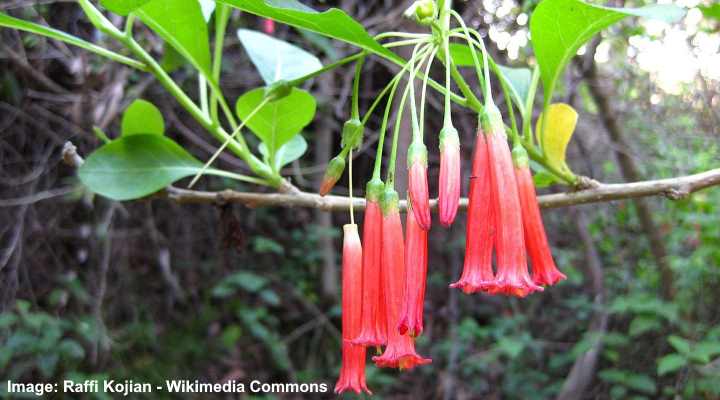
Red Iochroma Vine (Iochroma fuchsioides)
The red iochroma is a rapidly-growing large shrub characterized by its vivid red, trumpet-shaped flowers. The shrub has evergreen, shiny, ovular leaves that have a bright green hue. Since it likes to spread out, regular pruning is necessary to control the shrub’s growth.
This red iochroma does well in regions that have warm, temperate conditions. When planning your landscape, consider using it as a standalone plant or placing it at the back of a border.
- USDA zone: 8 to 11
- Size: 6 to 8 ft. (1.8 to 2.4 m) tall and wide – can grow taller
- Light Exposure: Full sun, shade in hotter climates
- Soil: Well-drained soil
Waratah (Telopea)

The waratah is an attractive, multi-stemmed shrub known for its unique, bright red flower heads. The flower heads contain small, curved flowers that grow on tall, erect stalks. Numerous bracts in vibrant red or pink colors encircle each flower head.
The waratah grows in a tight, compact form and has simple, glossy, dark green leaves with jagged edges. In your landscape, you can choose to plant it as a focal point or position it at the back of a border. Its unique flower heads also make it an excellent choice for floral arrangements.
- USDA zone: 8 to 10
- Size: 3 to 10 ft. (1 – 3 m) tall and wide
- Light Exposure: Full sun to partial shade
- Soil: Slightly acidic, sandy, well-drained soil
Calycanthus × raulstonii ‘Hartlage Wine’

Calycanthus × raulstonii ‘Hartlage Wine’ is a dense, multi-stemmed shrub identified by its lightly-scented, magnolia-like, maroon-red flowers. It has arching branches with opposite, oval-shaped, deep-green leaves. The leaves transition into an attractive yellow hue in autumn. In gardens and parks, this appealing shrub is excellent for making a statement on its own or for foundation plantings.
- USDA zone: 5 to 9
- Size: 8 to 10 ft. (2.4 – 3 m) tall
- Light Exposure: Full sun to partial shade
- Soil: Moist, well-drained soil
Nodding Pincushion (Leucospermum Cordifolium)

The nodding pincushion is a rounded, evergreen shrub identified by its large, globe-shaped flower heads. The pincushion-like flower heads range in color from yellow to red. The leaves of this shrub are oval-shaped, robust, and have a grayish-green hue with a thin covering of fine hairs.
The nodding pincushion’s blooming season lasts from spring to summer. The shrub is a versatile addition, ideal for flower arrangements, as a striking focal point, distinctive specimen plant, or container plant.
- USDA zone: 9 to 11
- Size: 5 ft. (1.5 m) tall
- Light Exposure: Full sun
- Soil: Well-drained, slightly acidic soil
Red Bougainvillea Shrub
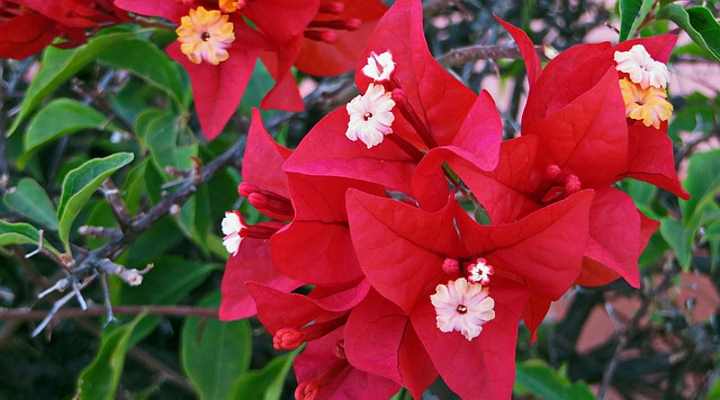
Bougainvillea is a flowering climbing plant that comes in various colors and thrives in full sun
The bougainvillea is a spreading, perennial shrub known for its abundant magenta, pink, or red flower-like bracts. Other identifying features include heart-shaped, dark green leaves, thick thorny stems, and small, creamy flowers surrounded by red leafy bracts. If supported, the shrubs can grow 15 to 40 ft. (4.5 – 12 m) wide or tall.
Bougainvillea shrubs are easily recognizable in a tropical environment. These woody vines typically creep up walls or cover trellises and arbors. The sprawling, woody vine can be trained to grow as a shrub. It is the perfect pick for hot summer landscapes when you want a privacy hedge or pergola plant.
Plant the bougainvillea shrub in a pot to achieve a compact, tree-like form.
The vivid colors of red bougainvillea shrubs last all season because the ‘flowers’ are actually modified leaves called bracts.
- USDA zone: 9 to 11
- Size: 15 to 40 ft. (4.5 – 12 m) wide or tall (if supported)
- Light Exposure: Full sun
- Soil: Sandy, well-drained soil
Chinese Fringe Flower (Loropetalum chinense ‘Ever Red’)

Chinese Fringe Flower (Loropetalum chinense ‘Ever Red’)
The Chinese fringe flower ‘Ever Red’ is an evergreen, compact shrub with bright red flowers. The flowers bloom from late winter to early spring and are known for their ribbon-like petals. The red blooms contrast beautifully with the dark burgundy, leathery leaves.
The Chinese fringe flower ‘Ever Red’ reaches 6 ft. (1.8 m) tall. The attractive red-flowering shrub can be grown as a specimen plant in full sun. Other landscaping ideas include planting as a privacy screen, hedge, foundation plant, or container plant.
- USDA zone: 7 to 9
- Size: 6 ft. (1.8 m) tall
- Light Exposure: Full sun
- Soil: Humus-rich, moist, well-drained soil
Abutilon ‘Bella Red’

Abutilon ‘Bella Red’ is a mounded, upright shrub recognized for its bell-shaped red flowers with a yellow center. The nectar-rich flowers attract various pollinators, such as hummingbirds and bees. This shrub also has lobed, palmate leaves with a light green hue. You can grow it beautifully in pots or right in the front yard as a standalone plant.
- USDA zone: 9 to 10
- Size: 1.4 ft. (0.4 m) tall and wide
- Light Exposure: Full sun to part shade
- Soil: Moist, well-drained soil
Red Flowering Azalea Shrubs (Rhododendron spp.)
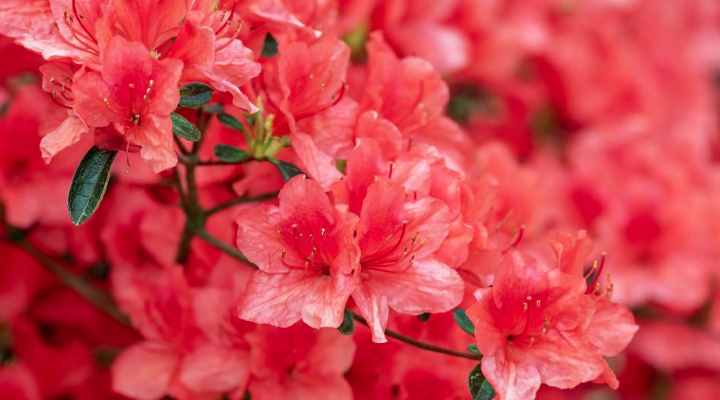
Red Azalea Shrubs
Red azalea shrubs are known for their abundant clusters of showy red flowers that bloom from mid-spring until summer. A wide selection of azaleas with red blossoms are available. The red flowers come in various sizes, ranging from 3 inches (7.5 cm) in diameter for larger blooms to small pinkish-red flowers measuring 1.5 inches (3.8 cm).
Azaleas come in both evergreen and deciduous varieties and bloom in white, lilac, pale pink, orange, yellow, and bright red. The red azalea can produce eye-catching flowers with double layers of ruffled petals.
Red azalea shrubs perform best in full sun to partial shade. In milder climates, these reliable spring-blooming shrubs might keep flowering into the fall. Some hardy azalea varieties, such as ‘Hino Crimson,’ ‘Flame Azalea,’ and ‘Girard’s Fuchsia,’ do well in USDA zone 5.
- USDA zone: 6 to 9
- Size: 3 and 6 ft. (1 – 1.8 m) tall and wide
- Light Exposure: Full sun to partial shade
- Soil: Moist, well-drained soil
Red Flowering Rose Bushes (Rosa)
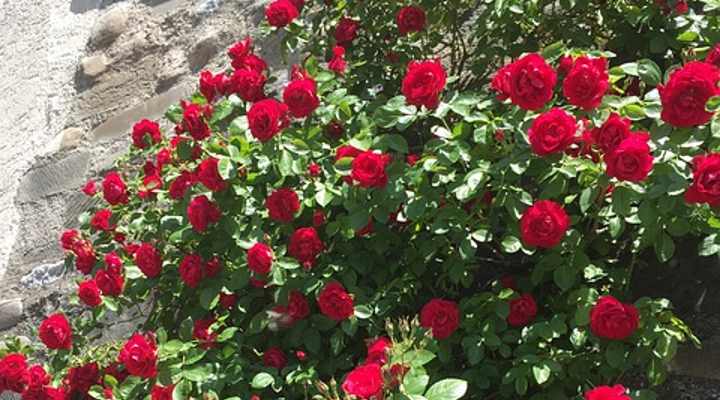
Red Rose Bushes (Rosa)
Some rose varieties are known for their attractive red flowers, which often symbolize passion and romance. Red rose bushes boast striking, vibrant blooms that are sure to improve the appearance of any landscape. The red perennial bushes burst into summer bloom, sporting sizable, multi-petaled red flowers that sprout from the woody stems. Additionally, the flowers can be identified by their rosette form.
Red shrubby roses typically grow between 4 and 6 ft. (1.2 – 1.8 m) tall. For optimal outcomes, place the shrubs in direct sunlight, ensuring they receive a minimum of six hours of sun each day. The lovely red flowers emit a delightful scent and make a stunning addition as a security barrier, foundation plant, stand-alone feature, or border shrub.
- USDA zone: 5 to 11
- Size: 4 and 6 ft. (1.2 – 1.8 m) tall
- Light Exposure: Full sun
- Soil: Well-drained soil
Red Hibiscus Shrubs (Hibiscus)
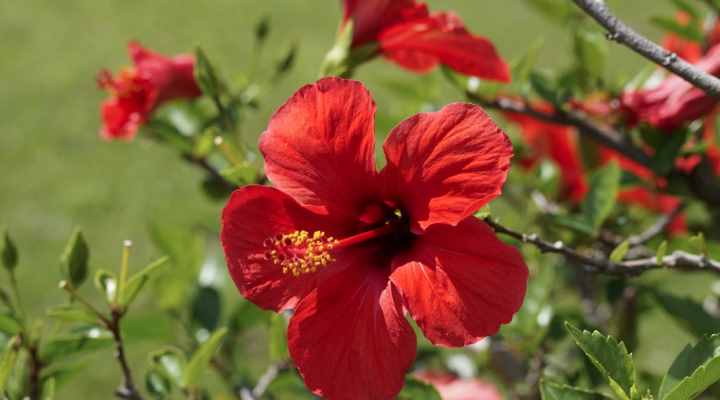
Tropical Hibiscus (Hibiscus rosa-sinensis)
Hibiscus shrubs are known for their beautiful, trumpet-shaped red, orange, pink, yellow, and white flowers. Red hibiscus flowers feature fragile, wrinkled petals that fan out in a star or funnel shape. Hibiscus shrubs display red, sweet-smelling flowers that can grow as wide as 8 inches (20 cm), blooming during the summer and fall.
Hibiscus shrubs come in two main varieties: tropical hibiscus and hardy hibiscus, also known as rose mallow. Tropical hibiscus thrives in gardens within zone 10 and higher, while hardy hibiscus is a great choice for USDA zones 5 to 9.
The rose of Sharon hibiscus is a widely encountered garden shrub known for its late-blooming nature and tall growth, reaching heights of 8 to 12 ft. (2.4 – 3.6 m). It is characterized by its impressive, funnel-shaped flowers.
- USDA zone: 5 to 11
- Size: 8 to 12 ft. (2.4 – 3.6 m) tall
- Light Exposure: Full sun
- Soil: Slightly acidic, organically rich, well-drained soil
Blue Flowering Shrubs (with Pictures): Identification Guide
Below are some blue flowering shrubs you should plant in your garden:
Blue-Flowering Mophead Hydrangea (Hydrangea macrophylla)
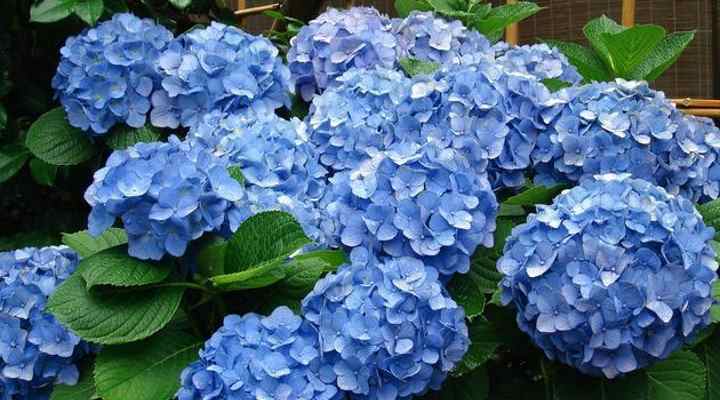
Hydrangea macrophylla ‘Nikko Blue’
Hydrangeas are well-loved as blue-flowering shrubs for partial shade planting. Mophead hydrangeas are known for their large, showy flowerheads. The flowerheads consist of densely packed, blue star-shaped florets arranged in a rounded shape. The shrub’s opposite, serrated, dark green leaves contrast beautifully with the blue flower clusters. This shrub grows 3 to 6 ft. (1 – 1.8 m) tall and wide.
- Mature Size: 4 to 6 ft. (1.2 – 1.8 m) tall and wide
- USDA Hardiness Zones: 6 to 9
- Light: Partial shade
- Soil: Acidic, organically rich, well-drained soils
Blue-Flowering Mountain Hydrangeas (Hydrangea serrata)
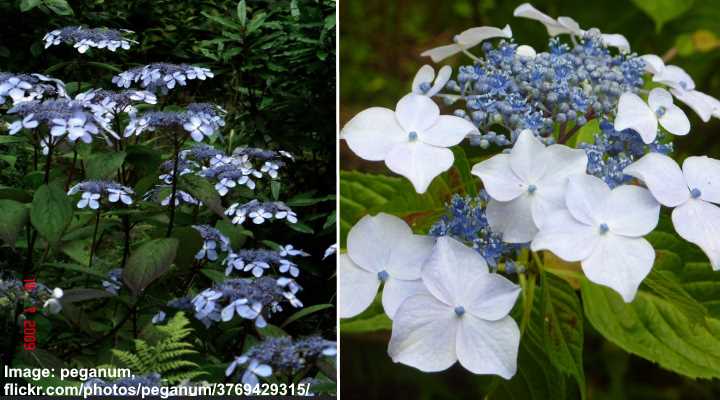
Mountain hydrangea is a group of attractive deciduous shrubs, featuring spectacular pale blue and light pink lacecap blooms. These compact shrubs, known for their blue flowers, tend to reach 3 to 4 ft. (1 – 1.2 m) in both height and width. Similar to other hydrangeas, these shrubs require acidic soil to produce blue blossoms. If proper soil is not ensured, these shrubs will produce pink flowers.
- Mature Size: 3 to 4 ft. (1 – 1.2 m) tall and wide
- USDA Hardiness Zones: 6 to 9
- Sun Exposure: Partial shade
- Soil Type: Well-drained acidic soil
California Lilac (Ceanothus)

California lilacs are spreading, evergreen shrubs identified by their striking clusters of dark blue flowers. From spring to fall, these shrubs feature cobalt, azure, and indigo flowers, as well as holly-like, glossy green leaves. The stunning blue flowers emit a delightful fragrance and cover the shrub, drawing in pollinators such as bees and butterflies.
These blue-flowering shrubs, also referred to as blueblossom or wild lilac, flourish in diverse soil conditions. These easy-care, bushy shrubs have outstanding visual appeal.
You have the option of growing California lilacs as a centerpiece in a container garden, foundation plant, or in a shrub border. It’s an excellent choice for coastal gardens due to its ability to tolerate salt air.
- Mature Size: 15 to 20 ft. (4.5 – 6 m)
- USDA Hardiness Zones: 7 to 11
- Sun Exposure: Full sun or partial shade
- Soil Type: Well-drained soil
Creeping Blue Blossom (Ceanothus thyrsiflorus var. repens)
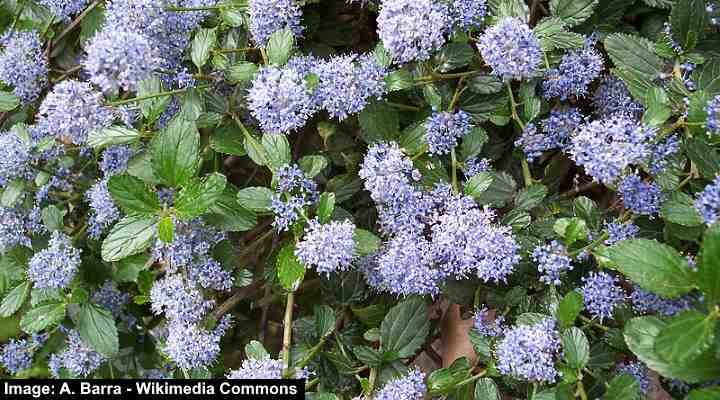
Creeping Blue Blossom (Ceanothus thyrsiflorus var. repens)
Creeping blue blossom is a spreading evergreen shrub known for its sweet-smelling, sky-blue flowers. This low-growing shrub grows best in full sun and dry to medium moisture soils. This small shrub reaches a maximum height of 3 ft. (1 m) and can spread up to 10 ft. (3 m) in width.
This drought-tolerant creeping shrub is ideal for blue-flowering ground cover and erosion control. The shrub can be grown as a foundation plant, wall-side border, or to attract butterflies. This versatile shrub offers an easy way to introduce blue color and texture into your garden.
- Mature Size: 2 to 3 ft. (0.3 – 1 m) tall and 6 to 10 ft. (1.8 – 3 m) wide
- USDA Hardiness Zones: 7 to 11
- Sun Exposure: Full sun or partial shade
- Soil Type: Average soils with dry to medium moisture that drain well
Blue Chiffon Rose of Sharon (Hibiscus syriacus ‘Blue Chiffon’)
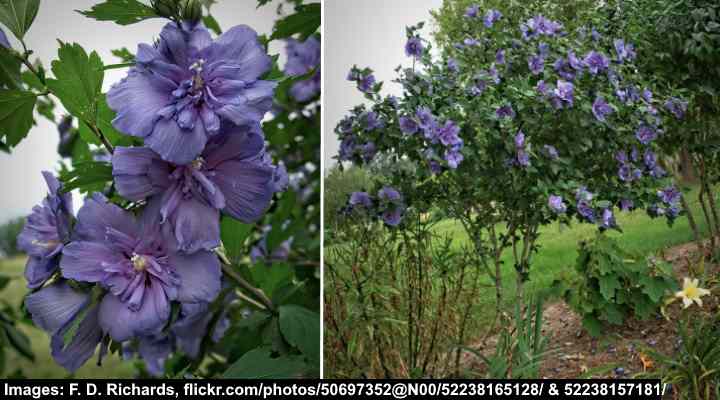
Rose of Sharon ‘Blue Chiffon’ is a beautiful deciduous shrub known for its tropical, semi-double pale blue flowers. The unique, purple-blue blossoms have a diameter of 4 inches (10 cm). The shrub has a star-shaped reddish-purple mark at the bottom of the frilly outer petals. These blue flowers make an appearance from mid-summer through early fall, attracting butterflies and hummingbirds.
Also known as Hibiscus syriacus ‘Notwoodthree,’ this shrub reaches 12 ft. (3.6 m) tall. The hardy shrub is tolerant of heat, humidity, drought, and salty air. It is also tolerant of poor-quality soils. This shrub is well-suited for USDA zone 5 and above, making it a versatile choice for hedges, blue-flowering borders, privacy screens, or foundation plantings.
- Mature Size: 8 to 12 ft. (2.4 – 3.6 m) tall, 4 to 6 ft. (1.2 – 1.8 m) wide
- USDA Hardiness Zones: 5 to 9
- Sun Exposure: Full sun
- Soil Type: Wide range of soil conditions, but prefers organically rich soils
Russian Sage ‘Blue Spire’ (Perovskia atriplicifolia ‘Blue Spire’)

The Russian sage ‘Blue Spire’ is an upright, deciduous shrub with clusters of small, dark blue flowers. This hardy flowering subshrub blooms from summer to fall, with fragrant gray-green leaves and slender spikes of bluish-purple flowers, forming fuzzy clusters. The drought-tolerant shrub grows up to 3 ft. (1 m) tall.
When it comes to garden landscaping, the Russian sage offers a wide range of uses. This small blue-flowering shrub is perfect for xeriscapes, mass plantings, as a border shrub, or for planting along a fence line. In addition, the shrub attracts pollinators such as butterflies and bees to the garden. Its stems also provide visual interest during winter.
- Mature Size: 2 to 3 ft. (0.6 – 1 m)
- USDA Hardiness Zones: 4 to 9
- Sun Exposure: Full sun
- Soil Type: Dry to medium, well-drained average soils
Rosemary (Rosmarinus officinalis)

The rosemary is a beautiful evergreen shrub featuring small, light blue or dark purple-blue flowers. Rosemary shrubs are easily recognizable by their erect, flowering woody stems, gray-green needle-like leaves, and two-lipped tubular blooms.
The rosemary shrub can reach 6 ft. (1.8 m) in height and has a bushy, upright growth habit. Besides their ornamental value in herb gardens, rosemary shrubs infuse stews, soups, and meats with a distinctive woody fragrance. It is also often used as a low-growing hedge or border plant in landscaping.
- Mature Size: 2 to 6 ft. (0.6 – 1.8 m)
- USDA Hardiness Zones: 8 to 11
- Sun Exposure: Full sun
- Soil Type: Well-drained, dry, sandy, or loamy soils
Cape Leadwort (Plumbago auriculata)
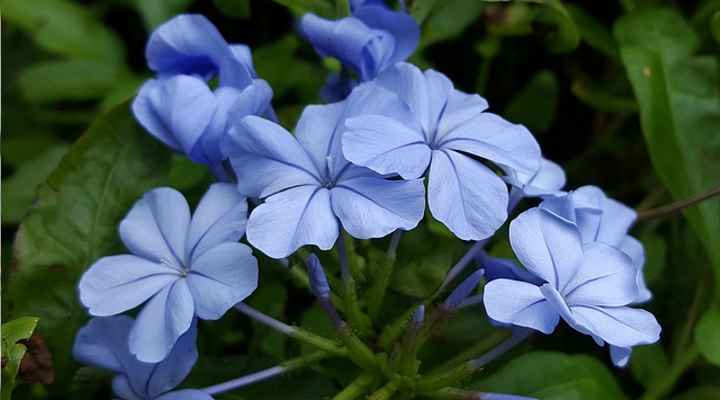
Cape Plumbago (Plumbago auriculata)
The cape leadwort is a sprawling evergreen shrub characterized by its clusters of tiny, pale-blue flowers. The vining shrub is known for its five-lobed, trumpet-shaped flowers, its long blooming period, and evergreen leaves on arching branches.
Cape leadwort flowers attract butterflies and bees as they continuously bloom from spring through fall. Due to its spreading nature, this shrub is excellent for evergreen ground cover, border planting, or as a climbing vine on trellises and fences. The luscious evergreen leaves create a beautiful contrast against the sky-blue flowers.
- Mature Size: 6 to 10 ft. (1.8 – 3 m) tall and 8 to 10 ft. (2.4 – 3 m) wide
- USDA Hardiness Zones: 8 to 11
- Sun Exposure: Full sun to partial shade
- Soil Type: Organically rich, well-drained soils if protected from strong winds
Blue Potato Bush (Lycianthes rantonnetii)

The blue potato bush is an attractive evergreen shrub with trumpet-shaped purple-blue flowers. The fragrant blooms are easily identifiable, featuring vibrant, golden-yellow centers. These contrast well with the glossy green, oval-shaped leaves. The rapidly-growing shrub is tolerant of heat and drought, as well as suitable for planting in deer-resistant gardens.
Blue potato bush shrubs can reach heights of up to 12 ft. (3.6 m). The shrub can also be trained to climb over a trellis or arbor. Additionally, it enhances the overall look of mixed flower beds, providing coverage for fences or walls.
- Mature Size: 8 to 12 ft. (2.4 – 3.6 m) tall and 6 to 10 ft. (1.8 – 3 m) wide, or up to 15 ft. (4.5 m) as a scrambling climber
- USDA Hardiness Zones: 9 to 11
- Sun Exposure: Full sun
- Soil Type: Moist, well-drained soil
Related articles:
